
SailingEurope Blog - Sailing, Yacht Charter and Beyond
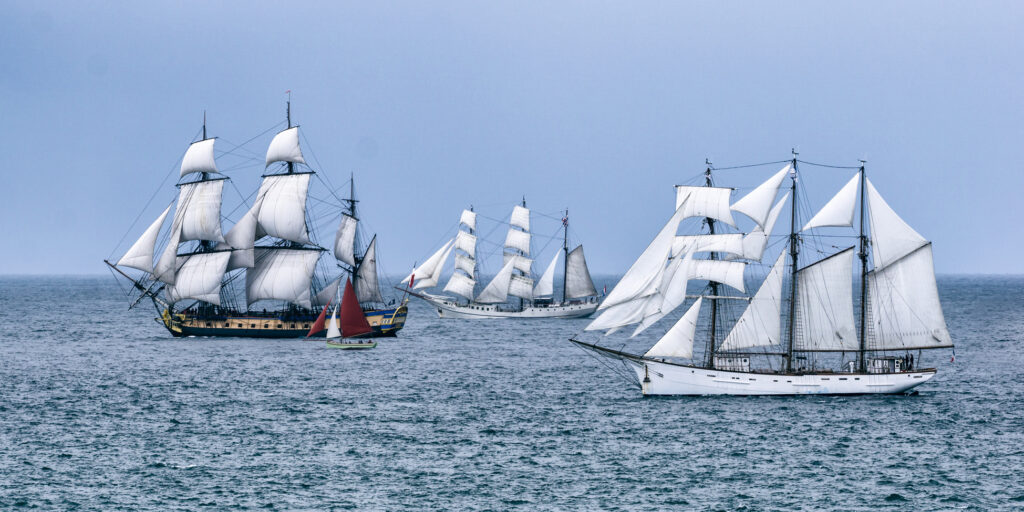

The Yacht – The Meaning and the Origin of the Word
In my language there are a few words for a floating object, or a vessel. According to the size and the purpose of the vessel, those words could be translated as “dinghy”, “yacht”, “boat” or “ship”. Some types of vessels have international names, for example “catamaran” or “hovercraft”.
What Does Yacht Mean?
However, when you say “ yacht” in my language, everyone know exactly what it is about. The word “yacht”, unlike other terms, has certain connotations. It always links with something classy, fancy, wealthy, elegant, and even glamorous.
For example, if you say that you have spent a week aboard a sailing boat , the recations of people will be more or less neutral. On the other hand, if you say that your week aboard a yacht was excellent, many people will become jealous. They will imagine you in a scene from a James Bond movie : aboard a massive white yacht in Monte Carlo , having a cold martini (shaken, not stirred)…
I wanted to share with you this language introduction because I found an interesting story about the word “yacht” and its origin. The word “yacht” became an English and an international term after an event that happened a long time ago.
How Do You Spell ‘Yacht’?

This word comes from the Dutch word “jacht”, which means “hunt”. Furthermore, “ j achtschepen” was the name for narrow, light and very fast sailing boats that the Dutchmen were using for intercepting larger and slower boats and ships.
One of the ‘hunters’ was given as a present to the British king Charles II . In His Majesty’s free time this vessel was not used for intercepting. Instead, was using it for fun. That is why the word “yacht” eventually became the term for vessels/boats made for pleasure.
I would highly appreciate comments from the native speakers of the English and Dutch languages. Especially since I am not one of them. No matter whether this story is true or not, it still sounds interesting to me.
Find out more about sailing quotes and phrases here .
I wish you a calm sea, a fine wind and a strong mast!
8 thoughts on “The Yacht – The Meaning and the Origin of the Word”
I looked up the origin of the word yacht, and it said it is a mid 16th century, Early Modern Dutch word from ‘jaght,’ from ‘jaghtschip’ meaning “fast pirate ship,” from ‘jaght’ which means “hunting” + ‘schip’ meaning “ship”.
I like the story of King Charles. It makes sense that that is why a yacht has the definite aura of wealth and pleasure!
Almost but not 100%. Actually the verb ‘jagen’ to hunt goes back to middle high German,i.e. Deutsch not Dutch, and before that it was ‘jagon’ in lower high German. But it seems that it all started with Greek and travelled North.
I guess that mid 16th century, the Dutch word jaght or jaghtschip was the word that got picked up. Not the earlier middle high German word where it came from.
Today it is jacht in Dutch, meaning hunting and it also the word for a luxury sailing boat.
In German Jagd is the word for hunt. Germans use the Dutch or English Jacht or Yacht for the boat.
Did the Germans design the original schooners? I think not! Since some Netherlanders speak a form of the Deutschland language, this word is shared (jacht/Dutch—jagd/German: meaning to hunt). It was the Dutch (Netherlanders) who designed the “flyut” or flute sailing ships, l-o-n-g before any British ever thought of such a ship—and—any German. The schooner grew out of the basic designs of the Dutch flute sailing ship (known for it’s speed). The Dutch economy relied heavily on trade and shipping, and were, thus, cutting edge innovators in ship building. Their engineering skills, was and is, plainly seen in their dike system, as well.
My father built a beautiful wooden replica of the”yacht” referred by the author (“Yacht Mary”) which was a present from the city of Amsterdam to King Charles II of England in 1660. They wrecked the ship a few years later (already too much partying on yachts, perhaps?)
I noticed the plaque that came with the model ship spelled the name as “Yatch” Mary. First, I thought, maybe, it was old English or Dutch spelling but it looks like it was just an error.
Nice, We have made an eplainermovie about this subject!
https://www.youtube.com/watch?v=l3HDZHF8w2E
In my head yogurt used to be spelled yoghurt and yacht used to be spelled yaught. Am I completely mis-remembering?
Dear Margaret, you are quite right for the spelling of the word yogurt that used to be, and sometimes still is, spelled with its old spelling yoghurt. However, there are no traces of the word yacht to have ever been spelled as yaught, but it would be best to take an etymology expert’s word for it.
Leave a Comment Cancel Reply
Your email address will not be published. Required fields are marked *
Save my name, email, and website in this browser for the next time I comment.
This site uses Akismet to reduce spam. Learn how your comment data is processed .

Yacht : modern meaning of the term and types of boats

The etymology of the term yacht comes from the Dutch word ‘jacht’, which was used in the past to define the fast sailing vessels used to hunt down pirates along the coasts of northern Europe.
Today, the term ‘yacht’ is used to describe all recreational vessels, whether sailing or motor-powered, with at least one cabin that allows the crew to sleep on board.
There is no established definition for the length of this family of boats, but common usage tends to define a yacht as a vessel longer than 33 feet, or about 10 meters.
As mentioned above, a yacht may be equipped with sailing, motor or mixed propulsion. It can have more than one hull, and if it exceeds 25 meters it also deserves the definition of superyacht . When a yacht is over 50 meters it is called a megayacht and, more and more frequently, when it exceeds 100 meters it becomes a gigayacht.
A yacht normally flies a flag that corresponds to the country where the vessel is registered, not least because, if it does not, it may be captured and taken to the nearest port for ‘flag survey’. As far as international maritime law is concerned, the yacht is considered in all respects to be the territory of the country of the flag it flies, to whose sovereignty the crew is subject.
A yacht flying the flag of a country, unless there is well-founded suspicion of illegal activity, can only be stopped for inspection by the military vessels of that country. When a yacht enters the territorial waters of a country other than that of its flag, it is obliged to fly a courtesy flag.
This is tantamount to a declaration of submission to the navigational laws of the country in which it is sailing.
Sailing and motor-powered yachts
The first major distinction is between sailing yachts and motoryachts. The current worldwide spread of these two families has shifted decisively towards motor yachts, which make up about 75% of the total sailing fleet.
Progress and design have produced many different categories of motor yachts, so let’s discover them together.
Motoryachts
Seen from the stern, a flybridge yacht is often equipped with a “beach club”, a platform that facilitates access to the sea and on which water toys are placed or simply used for diving. A staircase, or even two symmetrical staircases, leads from this platform to the main deck. Sometimes there is a “garage” between these two staircases to house the engine room, a tender and other on-board equipment.
The main deck is characterized by the presence of a helm station, inside of which a large open-space salon houses settees and a galley. The helm station often leads below deck, also known as the lower deck, where the sleeping quarters, or cabins, are normally located.

The foredeck often has a large sundeck bordered by a “bowplate” for hauling anchor. The bow is often “fenced in” by the handrails, which are vital grips for safety at sea.
Let’s get to why a yacht is called a flybridge. The flybridge is an upper deck, open 360 degrees and often covered by a hard-top, a roof usually made of fibreglass. The flybridge usually has an additional helm station to steer from a more panoramic position. An additional galley is often located on the flybridge, as well as additional lounge seating and sun decks.
Open Yachts
An open yacht has no flybridge and its main deck is commonly all open. The helm station can frequently be sheltered by a T-Top. Below deck, depending on the length of the yacht, there are living spaces for the crew which may include dinette, cabins and facilities. Open yachts can be walk-around, i.e. with the possibility for passengers of walking freely around the perimeter of the boat, or they can have an enclosed bow and thus have a raised deck.
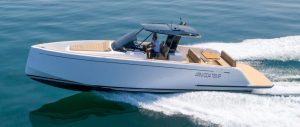
A coupe yacht is a yacht without a flybridge, characterized by a sporty design, with the main deck open aft. Very often it has a sunroof and is always equipped with side-decks connecting the stern to the bow. It is a vessel that, depending on its size, is suitable for medium to long-distance cruising.

This is an important type of yacht, which has its origins on the American East Coast where it was used to catch lobsters. It has a romantic, sometimes vintage aesthetic, and is endowed with sinuous lines that, for some, are evocative of the 1950s. Very suitable for cruising and conviviality, thanks also to a large sofa in the cockpit, the lobster is an iconic boat that offers plenty of comfort and space below deck for at least one cabin and one head.
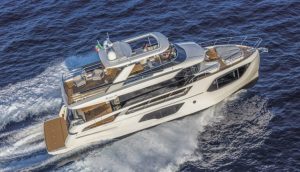
The trawler is essentially a yacht for owners who want to spend a lot of time on board. This is why interior volumes are maximized and the upper deck is always present. Also part of the trawler family are the famous Menorcan boats, inspired by the llaüts of the Menorca island..
Increasingly popular among motor yachts, too, is the multihull, due to its inherent features of stability and capacity. In most cases it is a catamaran designed for long stays at sea.
Sailing yacht
Sailing yachts are vessels where propulsion should mainly rely on the power transmitted by the wind. In the past, sailing yacht engines were low-powered and mainly used for entering and leaving ports, but today, for obvious reasons of practicality and ease of use, they have enough power to make the sailing yacht cruise at a speed at least equal to its theoretical hull speed. This means that sailing yachts can be used efficiently even in the total absence of wind.
A sailing yacht can be rigged in many different ways, these being the most common in modern times:
Sloop : this is the most common rigging on modern boats, characterized by the presence of a single mast with a mainsail and a jib or genoa. Sloop rigging has become popular over the years because it is the easiest to handle with a small crew and also offers the best ease of use/sailing performance ratio.
Cutter : Widely used for long distance sailing, it is characterized by the presence of a mainsail and two jibs rigged on a single mast. Normally the two jibs are a genoa and foresail that are used individually, depending on the weather conditions.
Ketch : this is the most commonly used rig on two-masted sailing yachts, with a mainmast, rigged with a mainsail and genoa, and a mizzenmast, forward of the rudder shaft, rigged with a single mainsail. The splitting of the sails makes this type of yacht suitable for sailing in bad weather.
Yawl : exactly the same as a ketch but with the mizzen mast located aft of the rudder shaft.
Sailing yachts can be monohulls or multihulls, i.e. catamarans or trimarans, but in all cases they can be divided into these categories:

Easy to handle and with plenty of space above and below deck, this type of yacht is normally characterized by an unbalanced length/width ratio favouring the latter, a small sail area and more powerful than average engines.
The interiors are fully equipped and sophisticated, with each cabin often having its own en-suite head.
The deck plan and sailing equipment are simplified, often electrified and minimal.
Cruiser-Racer

This yacht, while still featuring a luxurious and complete interior, also has all the equipment needed for sail fine-tuning and a generous sail area.
This is a category where special attention is paid to both the overall weight of the boat and the hull shape.
The hull lines are in fact designed to enhance performance and, inevitably, this results in a slightly smaller interior than that of pure cruising yachts of the same length.
Racer-Cruiser

The owner who buys this type of yacht has already competed in club competitions and now wants to engage in higher level racing. The hulls are light and can sometimes be made of carbon, and all the sail adjustments are fine-tuned to achieve maximum performance.
The deck plan is definitely designed for crewed racing and the sail area/displacement ratio is unbalanced in favour of the former, making this yacht more difficult to handle with a smaller crew but, conversely, capable of performance similar to a pure racing yacht.
A pure racing yacht is a sailing yacht built exclusively for racing. Free from any commercial constraints, it is built according to the type of race to be competed in and, above all, the rating to be obtained. The interiors of this boat are minimal. This yacht is capable of planing and sailing upwind at very low wind angles, but is almost never used for recreational purposes.

Leave a Reply Cancel reply
Your email address will not be published.
Save my name, email, and website in this browser for the next time I comment.
You might be interested in

Boat blowers: how to choose the best model

Boat gangways: guide to proper maintenance and cleaning

Choosing the perfect cradle: boat stands, cradles, heels and trailers
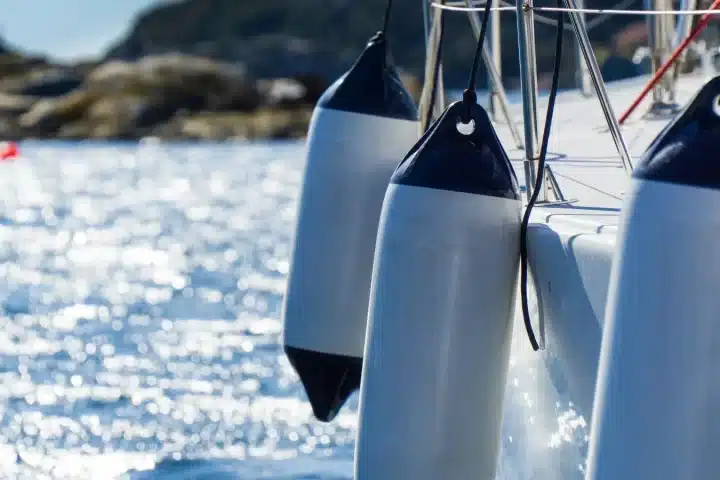
Boat Fenders: how to choose and use them properly
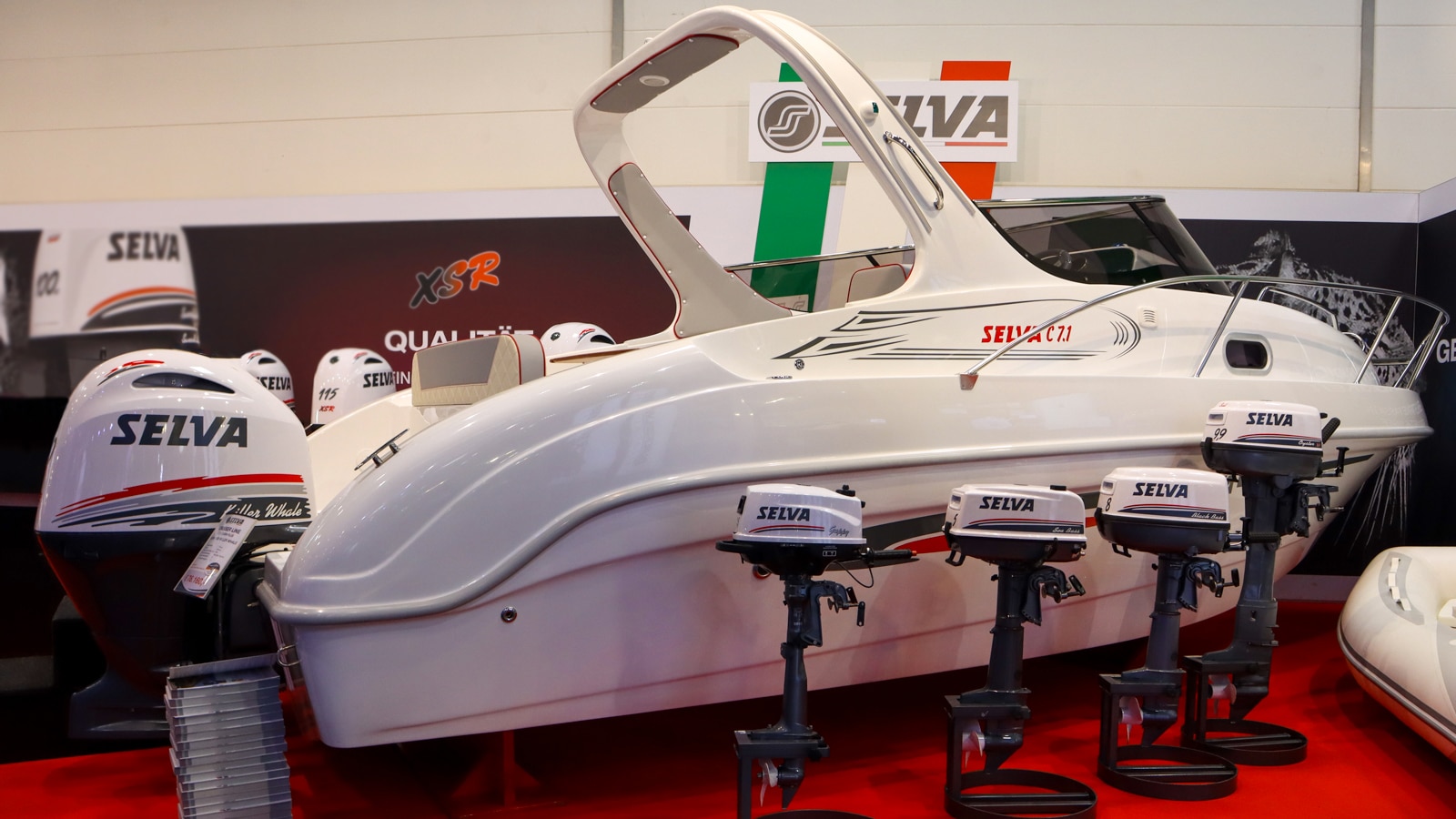
Selva C.7.1 Cabin Plus: comfort combines with practicality
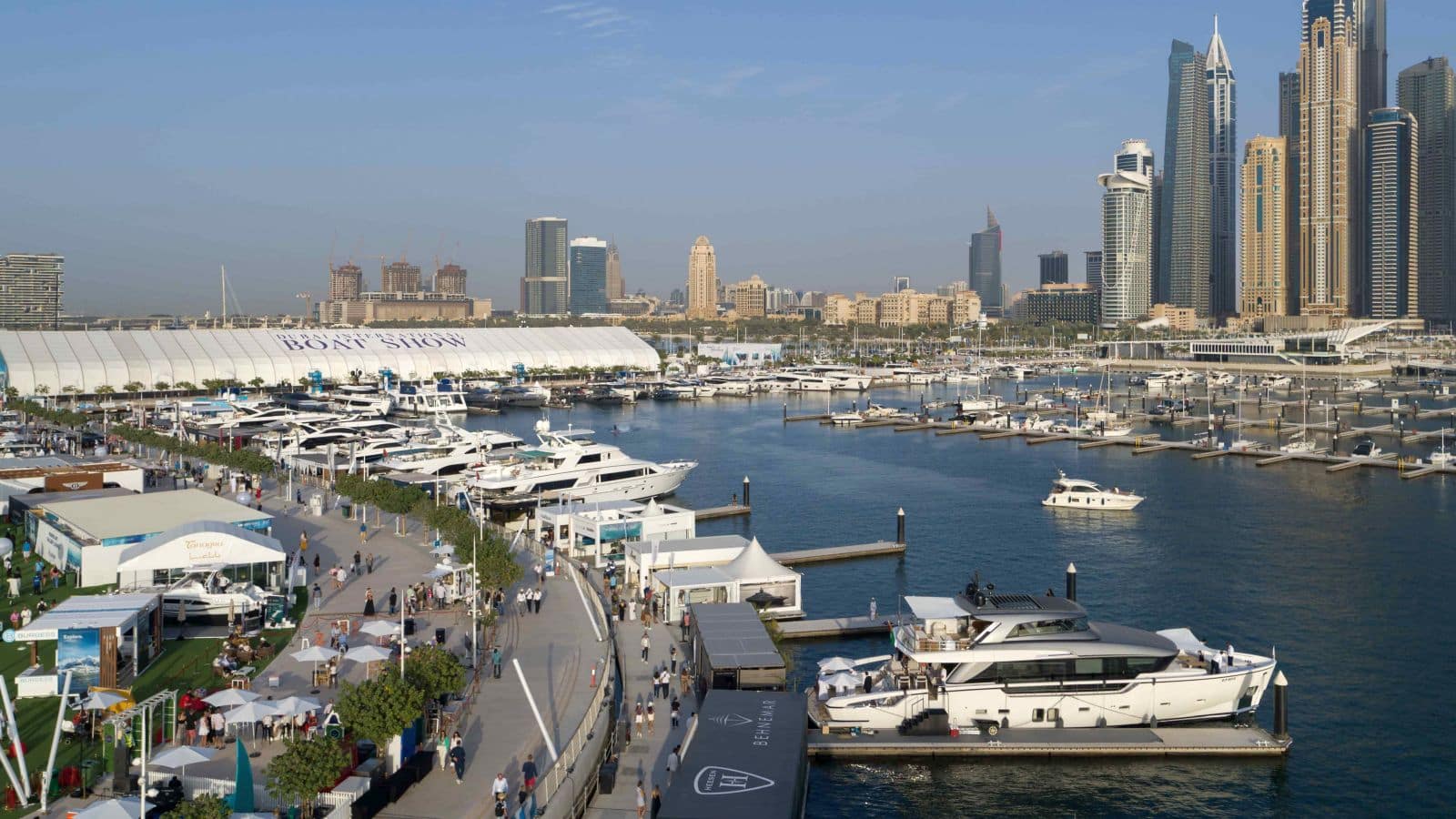
All set for the Dubai International Boat Show 2023

To provide the best experiences, we and our partners use technologies like cookies to store and/or access device information. Consenting to these technologies will allow us and our partners to process personal data such as browsing behavior or unique IDs on this site and show (non-) personalized ads. Not consenting or withdrawing consent, may adversely affect certain features and functions.
Click below to consent to the above or make granular choices. Your choices will be applied to this site only. You can change your settings at any time, including withdrawing your consent, by using the toggles on the Cookie Policy, or by clicking on the manage consent button at the bottom of the screen.
Subscribe For Latest Updates
Sign up to receive the best of Yachting News, sea trials, boat review and world premieres .
The only ADVERTISING FREE newsletter
- 1.1 Etymology
- 1.2 Pronunciation
- 1.3.1 Derived terms
- 1.3.2 Translations
- 1.4.1 Translations
- 1.5 Anagrams
- 2.1 Etymology
- 2.2 Pronunciation
- 2.4 Further reading
- 3.1 Etymology
- 3.2 Pronunciation
- 3.4 References
- 3.5 Further reading
- 4.1 Etymology
- 5.1 Etymology
- 5.3 References
- 6.1 Etymology
- 6.3 References
- 7.1 Alternative forms
- 7.2 Etymology
- 7.3.1 Declension
- 7.3.2 Derived terms
- 7.4 Further reading
English [ edit ]
Etymology [ edit ]
Circa 1557; variant of yaught , earlier yeaghe ( “ light, fast-sailing ship ” ) , from Dutch jacht ( “ yacht; hunt ” ) , in older spelling jaght(e) , short for jaghtschip ( “ light sailing vessel, fast pirate ship ” , literally “ pursuit ship ” ) , compound of jacht and schip ( “ ship ” ) .
In the 16th century the Dutch built light, fast ships to chase the ships of pirates and smugglers from the coast. The ship was introduced to England in 1660 when the Dutch East India Company presented one to King Charles II, who used it as a pleasure boat, after which it was copied by British shipbuilders as a pleasure craft for wealthy gentlemen.
Pronunciation [ edit ]
- ( UK ) enPR : yŏt , IPA ( key ) : /jɒt/
- ( US ) enPR : yät , IPA ( key ) : /jɑːt/ , /jɑt/
- Rhymes: -ɒt
Noun [ edit ]
yacht ( plural yachts )
- 1897 December (indicated as 1898 ), Winston Churchill , chapter X, in The Celebrity: An Episode , New York, N.Y.: The Macmillan Company ; London: Macmillan & Co., Ltd. , →OCLC : The skipper Mr. Cooke had hired at Far Harbor was a God-fearing man with a luke warm interest in his new billet and employer, and had only been prevailed upon to take charge of the yacht after the offer of an emolument equal to half a year's sea pay of an ensign in the navy.
- 1907 August, Robert W[illiam] Chambers , chapter VI, in The Younger Set , New York, N.Y.: D. Appleton & Company , →OCLC : “I don’t mean all of your friends—only a small proportion—which, however, connects your circle with that deadly, idle, brainless bunch—the insolent chatterers at the opera, [ … ] , the chlorotic squatters on huge yachts , [ … ] , the neurotic victims of mental cirrhosis, the jewelled animals whose moral code is the code of the barnyard—!"
Derived terms [ edit ]
- motor yacht , motoryacht , MY
- sailing yacht , steam yacht , SY
- yacht person
Translations [ edit ]
Verb [ edit ].
yacht ( third-person singular simple present yachts , present participle yachting , simple past and past participle yachted )
- ( intransitive ) To sail , voyage , or race in a yacht .
Anagrams [ edit ]
- Cathy , tachy , tachy- , yatch
French [ edit ]
Borrowed from English yacht , from Dutch jacht .
- IPA ( key ) : /jɔt/ , /jot/ , ( Canada ) /jat/
yacht m ( plural yachts )
Further reading [ edit ]
- “ yacht ”, in Trésor de la langue française informatisé [ Digitized Treasury of the French Language ] , 2012 .
Italian [ edit ]
Unadapted borrowing from English yacht .
- IPA ( key ) : /ˈjɔt/ [1]
- Rhymes: -ɔt
yacht m ( invariable )
- the letter Y in the Italian spelling alphabet
References [ edit ]
- ^ yacht in Luciano Canepari , Dizionario di Pronuncia Italiana (DiPI)
- yacht in Treccani.it – Vocabolario Treccani on line , Istituto dell'Enciclopedia Italiana
Norman [ edit ]
Borrowed from English yacht .
yacht ? ( plural yachts )
- ( Jersey ) yacht
Norwegian Bokmål [ edit ]
From Dutch jacht , via English yacht .
yacht m ( definite singular yachten , indefinite plural yachter , definite plural yachtene )
- “yacht” in The Bokmål Dictionary .
Norwegian Nynorsk [ edit ]
yacht m ( definite singular yachten , indefinite plural yachtar , definite plural yachtane )
- “yacht” in The Nynorsk Dictionary .
Swedish [ edit ]
Alternative forms [ edit ].
yacht c
Declension [ edit ]
- yacht in Svenska Akademiens ordlista ( SAOL )
- yacht in Svensk ordbok ( SO )
- yacht in Svenska Akademiens ordbok ( SAOB )
- English terms derived from Dutch
- English 1-syllable words
- English terms with IPA pronunciation
- English terms with audio links
- Rhymes:English/ɒt
- Rhymes:English/ɒt/1 syllable
- English lemmas
- English nouns
- English countable nouns
- English terms with usage examples
- English terms with quotations
- English verbs
- English intransitive verbs
- en:Watercraft
- French terms borrowed from English
- French terms derived from English
- French terms derived from Dutch
- French 1-syllable words
- French terms with IPA pronunciation
- French terms with audio links
- French lemmas
- French nouns
- French countable nouns
- French masculine nouns
- fr:Watercraft
- French loanwords with irregular pronunciations
- Italian terms borrowed from English
- Italian unadapted borrowings from English
- Italian terms derived from English
- Italian 1-syllable words
- Italian terms with IPA pronunciation
- Rhymes:Italian/ɔt
- Rhymes:Italian/ɔt/1 syllable
- Italian lemmas
- Italian nouns
- Italian indeclinable nouns
- Italian countable nouns
- Italian terms spelled with Y
- Italian masculine nouns
- Norman terms borrowed from English
- Norman terms derived from English
- Norman lemmas
- Norman nouns
- Jersey Norman
- nrf:Watercraft
- Norwegian Bokmål terms derived from Dutch
- Norwegian Bokmål terms derived from English
- Norwegian Bokmål lemmas
- Norwegian Bokmål nouns
- Norwegian Bokmål terms spelled with C
- Norwegian Bokmål masculine nouns
- nb:Watercraft
- Norwegian Nynorsk terms derived from Dutch
- Norwegian Nynorsk terms derived from English
- Norwegian Nynorsk lemmas
- Norwegian Nynorsk nouns
- Norwegian Nynorsk terms spelled with C
- Norwegian Nynorsk masculine nouns
- nn:Watercraft
- Swedish terms borrowed from English
- Swedish terms derived from English
- Swedish lemmas
- Swedish nouns
- Swedish common-gender nouns
- sv:Watercraft
- English entries with topic categories using raw markup
- Mandarin terms with redundant transliterations
- Mongolian terms with redundant script codes
- French entries with language name categories using raw markup
- Requests for gender in Norman entries
Navigation menu
- Understanding the yachting world: Definitions and origins
The world of yachting and sailing is a realm of elegance, adventure, and rich history. However, the terminology surrounding these nautical activities can sometimes be confusing. From the definition of a yacht to the spelling of various sailing-related terms, this article sets out to demystify the language of the seas, offering insight into the origins and meanings of these captivating words.
Decoding the yacht: Definition and origin
A yacht is more than a vessel; it's a symbol of luxury and sophistication. Derived from the Dutch word "jacht," meaning "hunt" or "chase," yachts were initially swift, maneuverable ships used for pursuit. Over time, yachts have evolved into opulent pleasure craft enjoyed by sailing enthusiasts and the elite.
Exploring the nautical term "sailing"
Sailing goes beyond moving through water using wind power; it encapsulates a spirit of exploration and freedom. It's the art of harnessing wind energy to navigate the vast oceans, representing a harmonious relationship between humans and nature.
Read our top notch articles on topics such as sailing, sailing tips and destinations in our Magazine .
Unveiling the word "yacht" and its meaning
The term "yacht" conjures images of sleek vessels gliding gracefully across the water. Its meaning, however, extends beyond aesthetics. A yacht signifies an elegant and luxurious ship, often associated with pleasure and leisure rather than utilitarian purposes.
Yachting in focus: Definition and significance
Yachting is the activity of sailing on a yacht, encompassing both recreational and competitive aspects. It's a way to experience the allure of the open waters while indulging in the comforts and amenities offered by these sophisticated vessels.
The intricacies of yacht pronunciation
The pronunciation of "yacht" varies across regions, with some emphasizing the "ch" sound, while others opt for a softer "y" sound. This linguistic diversity adds an interesting layer to the yachting world, reflecting the global appeal of sailing.
Luxury yacht
Name or yacht? Understanding the terminology
In the yachting community, the term "name yacht" refers to a yacht that is well-known and often carries a reputation. These yachts are associated with luxury, innovation, and the personalities of their owners.
Diving into the origins of yachts
The origin of yachts traces back to the 17th century Netherlands, where they were initially used for naval purposes and later transformed into vessels for recreational sailing. Their evolution mirrors the changing perceptions of sailing from utility to leisure.
Yacht vs. yatch: Spelling matters
The correct spelling is "yacht," and "yatch" is a common misspelling. Spelling accuracy is vital, especially in maritime communication, where precision ensures clear understanding and effective conveyance of information.
Sailing terminology: What is a dinghy?
A dinghy is a small, open boat often used for short trips, transportation between a larger vessel and the shore, or for recreational sailing. Dinghies come in various sizes and are an essential part of sailing activities.
Deciphering "catamaran" and its spelling
A catamaran is a type of boat characterized by two parallel hulls connected by a deck. The spelling is "catamaran," and understanding this term is crucial for discussing and identifying different types of vessels.
Sailing's essence: The word and its meaning
Sailing embodies more than the physical act; it's a metaphor for life's journey. Just as sailors navigate challenges on the water, individuals navigate the currents of their lives, guided by the winds of opportunity and the compass of determination.
The language of yachting and sailing is rich with history and significance. From the definition of a yacht to the meaning of sailing-related terms, understanding these words enhances our appreciation of the maritime world and the timeless allure of the seas.
So what are you waiting for? Take a look at our range of charter boats and head to some of our favourite sailing destinations .
FAQs about definitions and origins
In this article, we explain the definition, history and origin of the word yacht, and break down some of the more common types of yachts along with various styles and sizes.
Yacht Definition & Origin
The word yacht comes from the Dutch word “jacht”, which means to hunt, and refers to the quick and lightweight sailboats the Dutch navy used to pursue pirates and other enemies in shallow waters. Today, the word takes on a very different meaning. While there is no strict definition of the word today, a yacht is generally considered as a boat used for pleasure, whether you’re cruising open waters, racing or island-hopping for the weekend. Typically, we consider a boat to be a yacht if it has an overnight cabin onboard, is more than 33 feet long, and generally looks nicer than your average vessel.
Pleasure boats have been around for hundreds of years, which is no surprise when you consider our options for transportation around that time. Without planes, cars, bikes or scooters, humans turned to the one form of transportation they knew well for pleasure – the ship.
Sailing Yacht History
Sailing yachts have been a thing since at least the beginning of the 1660s in Europe, when King James of England commissioned a sailing yacht for his son Henry, the Prince of Wales. But it was Charles II, the Kind of Scotland, who brought the term “yacht” into the mainstream after spending time exiled in the Netherlands. Once Charles got home, he began commissioning royal yachts left and right.
Steam Yacht History
Steam Yachts also have quite the history, which started as massive and luxurious sailing yachts with steam auxiliary engines. These yachts were much larger, and carried full crews complete with a cook, captain, engineer, stewards and deck hands. By the late 1700s, screw propellers were installed and the engines became far more efficient. Eventually, compound engines came about and persisted until the internal combustion took over.
Power Yacht History
Powerboats with 4-stroke gas engines were first developed by Nicolaus Otto and Gottlieb Daimler in 1876. Then in the 1900s, diesel engines became the more popular option because of their lower cost and improved reliability.
Yacht Types
Today, yachts fall into one of two general categories – sailing yachts and motor yachts.
Sailing Yachts
A sailing yacht is a leisure craft that relies on its sails for the primary method of movement, made from natural, synthetic or carbon fibers. Sailing yachts are split into two main categories: cruisers and raisers.
Cruising Yachts
A cruising yacht is designed for comfort above anything else. These yachts are ideal for overnight and lengthy journeys, typically equipped with all the comforts of home, including full kitchens (galleys), bathrooms (heads) and beds. They’re also designed to be slightly easier to maintain.
At the smaller end, we have what’s called as a “trailer sailer”. These yachts are generally shorter than 25 feet, and can be pulled by the average car. But anything shorter than 33 feet is considered a small sailing yacht. The next level is 33-45 feet, referred to as near-shore yachts. Offshore yachts are the largest category, including vessels larger than 45 feet.
Racing Yachts
A racing yacht is designed with performance top of mind, rather than comfort. World Sailing, the governing body for the sport of international sailing, recognizes 11 different classes of sailing yachts, but each share some general characteristics.
On a racing yacht, aerodynamics is prioritized. These yachts come in a variety of shapes and weights, but performance is the underlying motivation for all. Similar to aerodynamics but underwater, hydrodynamically efficient hulls allow boats to pull through the water with minimal drag or extra motion. Finally, for peak performance, these sailing yachts typically use full-battened Kevlar or carbon fiber sails.
Motor Yachts
Motor yachts come in all shapes and sizes, built with a variety of different materials. Generally speaking, they range from 30-130 feet in length, but there are superyachts out there exceeding 500 feet (that’s over 150 metres!).
The hull of a motor yachts comes in three basic styles. A yacht with a full-displacement hull moves the water up and away, creating waves. These boats have the potential to be plenty powerful, but their speed is limited. Semi-displacement hulls are slightly faster, because they’re able to partially rise above the water. Last are the yachts with a planing hull. These yachts are the fastest, because of a flat underside and enough power to lift them onto the surface of the water.
The majority of modern motor yachts have at least one diesel engine. A boat with two engines is certainly more expensive, but well worth it when you consider the reliability and increased handling/performance.
When it comes to motor yacht styles, there are many. Here’s a brief introduction to a few different motor yacht styles:
- Sport Motor Yacht : These powerful crafts are built with a semi-displacement and planing hulls, making them fast boats great for weekend adventures and short trips.
- Trawler Motor Yacht : A trawler is known for its more traditional style with a displacement hull, designed for medium distance passage-making.
- Cruising Motor Yacht : A cruising yacht is built for comfortable longer distance travel, equipped with a displacement hull.
- Expedition Yacht : Similar to a cruising motor yacht, expedition yachts are built with a displacement hull for long distances, but these crafts specialize in passage-making in remote areas.
- Mega Luxury Yachts : The mega luxury yachts is what you see and hear about on TV and in magazines. They’re hundred of feet long, designed for dozens of family and friends, and reserved for the super-rich.
- Sports Fisherman Yacht : These yachts have semi-displacement or planing hulls for quick fishing trips where you need to be able to move well. On a sports fisherman yacht, there will also be extra space for fishing gear and large fish.
- Lobster Yacht : A lobster yacht is similar to but quicker than a trawler, built with a semi-displacement or planing hull. These yachts get their name from their unique style – looking like classic Maine lobster boats.
If you’re looking for a new yacht, browse our current listings of sailing and motor yachts at Van Isle Marina. You can also visit us in Sidney at 2320 Harbour Road to see our stock in person, and our staff will be happy to help you out.
250 656 1138
2320 Harbour Road, Sidney, British Columbia V8L 2P6 [email protected]
Marina Services
Marina Layout
Yacht Sales
- Share on Facebook
- Link to Instagram
©2024 Van Isle Marina | Design by Caorda


- Subscribe Now
- Digital Editions

Yacht definitions: What is a yacht? And does it need to have sails?
- Top stories
By far the most common question we get asked here at Motor Boat & Yachting is ‘how can you call that a yacht if it doesn’t have sails?’ Here we explain why a boat doesn’t need sails to be called a yacht...
What’s in a name? Quite a lot if you’re a yacht! Not only are the names of yachts a source of endless amusement, but by defining your boat as a yacht in the first place, you’re setting up certain expectations.
Yacht definitions: A brief history
Whilst boating for fun dates back to Ancient Egypt and possibly even further than that, the word yacht comes from the Dutch ‘jachtschip’, which means hunting ship. Jachts were originally a class of sailboat used in the 16th century to hunt down enemies of the Dutch Republic.
However by the 19th century the term ‘yachting’ had developed to mean recreational boating in general, and with the advent of steam boats, sails were no longer the only method of propulsion available to Victorian yachtsmen.
Article continues below…
World’s largest superyacht: Everything you need to know about 183m REV
Hemingway’s boat reborn: how pilar was recreated in meticulous detail, recommended videos for you.
In the early 20th century (1904 to be precise), our humble magazine was launched under its original title The Motor Boat , but by the 1950s the ‘& Yachting’ suffix had been added to refer to the general pastime enjoyed by motorboat owners. We even reviewed the occasional motorsailer for those who liked to enjoy the benefits of both power and sail.
Today’s Motor Boat & Yachting is dedicated purely to powered leisure vessels from 25-125ft with the occasional foray above and below that when interest dictates. Current editor Hugo Andreae insists that he is ‘terminology agnostic’ saying, “I’m not bothered whether people refer to their boats as yachts, cruisers, power boats or gin palaces just so long as they enjoy using them. But for the record my 22ft Karnic is definitely a gigayacht!”

Editor Hugo’s Karnic 2250 is his family’s pride and joy, but should it be called a yacht?
What makes a yacht, a yacht?
Some would argue that a yacht has to have sails, and as we’ve seen, that was originally the case, but we here at Motor Boat & Yachting beg to differ, as its common to refer to large motorboats as motoryachts, superyachts or even megayachts without any expectation that they would have sails.
Others assert that a yacht should have to have a cabin in order for it to be fully considered a yacht, or that it has to measure at least 10m in length. If that’s the case then some longer narrowboats could be technically considered as yachts, although you’d be hard pushed to find anyone who agrees with that definition.
The final test for something to be considered a yacht is harder to pin down, but it is generally accepted that all yachts have to have a certain aesthetic or architectural appeal in order to earn this haughty moniker.

The advent of internal combustion in the 19th Century allowed motor yachts, like this fine example from Camper & Nicholsons, to be launched. Photo: Getty Images
Whether a boat is worthy of being called a yacht is clearly subjective, but there’s one thing we won’t budge over – it certainly doesn’t have to have sails!
If it’s sailing yachts specifically that you’re interested in, you won’t find many of them here, but we can heartily recommend our sister titles Yachting Monthly and Yachting World , who know much more about them than we do.
Bigger yacht definitions: Superyacht, megayacht or gigayacht?
Beyond the simple term yacht, there are a few other yacht definitions worth clarifying. The most commonly used of which is superyacht .
The debate still rages over what constitutes a superyacht. Any pleasure yacht with a load line length of 24m or more (not length overall or waterline length as is often misquoted) and a gross tonnage of 80GT is classified as a Large Yacht under MCA coding rules, causing a number of additional regulations to kick in, most crucially the requirement for the skipper to hold a commercially endorsed Yachtmaster Offshore Certificate. This is the closest thing to a technical definition of a superyacht.
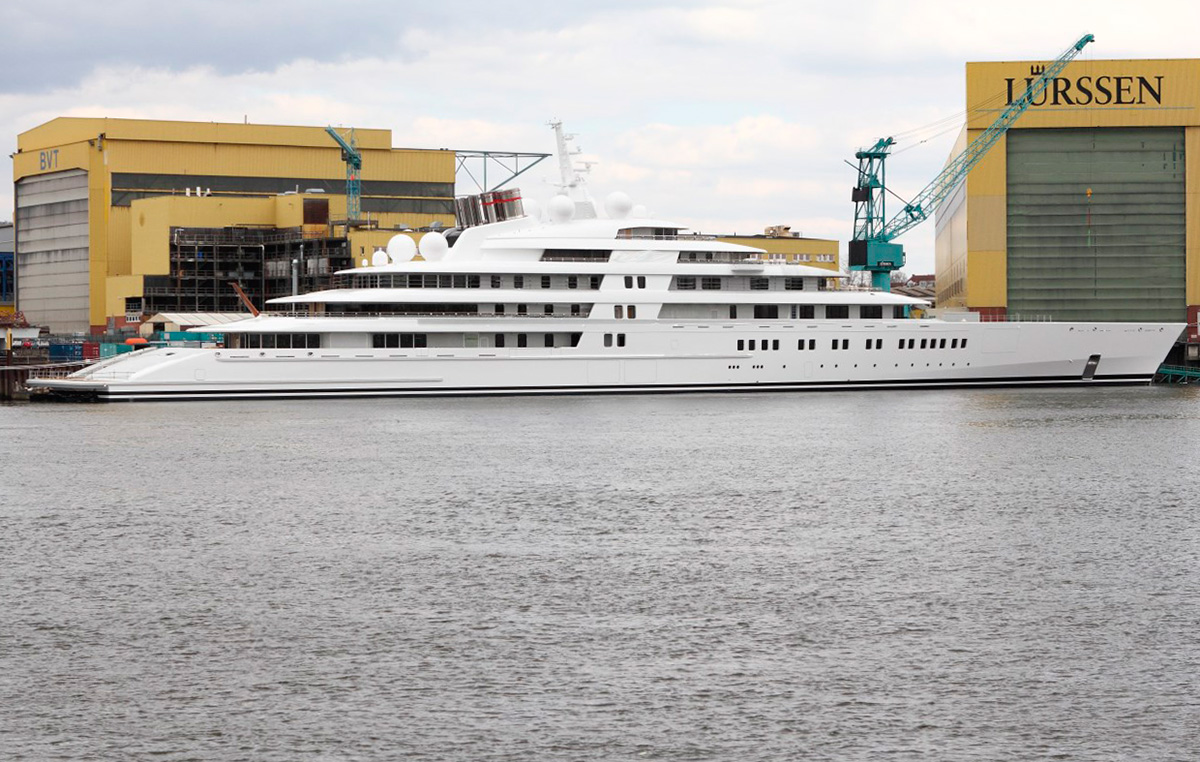
At 180m Azzam is currently the largest yacht in the world, but an 183m gigayacht called REV is currently under construction in Norway. Photo: Wikimedia Commons
However, while this used to mean most leisure boats with an overall length (LOA) of 80ft or more fell into the Large Yacht category, yards have become so adept at designing bigger boats with a load line length of just under 24m that many craft with an LOA of 90ft or more still count as regular pleasure vessels.
For that reason some people prefer to use the simpler definition of a superyacht being any privately owned vessel with an LOA of 100ft or more. Even then some would argue that a true superyacht should be a custom built yacht of at least 35m or 120ft.
Such is the inflationary pressure on yacht sizes and terminology that the term superyacht itself has begun to lose currency among the yachting elite. Owners of craft over 50m now use the term megayacht to categorise their larger vessels, while the lesser-spotted gigayacht is reserved for yachts over 100m.
Fewer than 100 gigayachts have been built to date, making this the rarest of rare breeds. That said with the world’s largest yacht now measuring over 183m, it’s surely only a matter of time before the 200m mark will be broken and yet another term will be needed. Got any suggestions? Drop us an e-mail: [email protected]

Quarken 35 T-Top first look: Open-plan with pilothouse echoes
Azimut grande 44 metri trideck first look, 4 of the best beginner motor boats to buy right now, latest videos, delphia 10 boat tour: great value family cruiser, galeon 560 fly tour: the coolest flybridge ever built, cormate utility 27 tour: 80mph rocketship at a price you won’t believe, saxdor 400 gtc tour: düsseldorf launch for new flagship.
- More from M-W
- To save this word, you'll need to log in. Log In
Definition of yacht
(Entry 1 of 2)
Definition of yacht (Entry 2 of 2)
intransitive verb
Examples of yacht in a Sentence
These examples are programmatically compiled from various online sources to illustrate current usage of the word 'yacht.' Any opinions expressed in the examples do not represent those of Merriam-Webster or its editors. Send us feedback about these examples.
Word History
obsolete Dutch jaght , from Middle Low German jacht , short for jachtschip , literally, hunting ship
1557, in the meaning defined above
1836, in the meaning defined above
Phrases Containing yacht
Articles related to yacht.

The Words of the Week - May 17
Dictionary lookups from the sea, the courts, and Europe

Dutch, Yiddish, Japanese, or Hindi? Quiz
Guess the language these English words come from.

Why does English have so many silent...
Why does English have so many silent letters?
Inexplicable silent letters, explained
Dictionary Entries Near yacht
yacht chair
Cite this Entry
“Yacht.” Merriam-Webster.com Dictionary , Merriam-Webster, https://www.merriam-webster.com/dictionary/yacht. Accessed 18 May. 2024.
Kids Definition
Kids definition of yacht.
Kids Definition of yacht (Entry 2 of 2)
from obsolete Dutch jaght (now jacht ), short for jachtschip, literally, "hunting ship"
More from Merriam-Webster on yacht
Thesaurus: All synonyms and antonyms for yacht
Nglish: Translation of yacht for Spanish Speakers
Britannica English: Translation of yacht for Arabic Speakers
Britannica.com: Encyclopedia article about yacht
Subscribe to America's largest dictionary and get thousands more definitions and advanced search—ad free!

Can you solve 4 words at once?
Word of the day.
See Definitions and Examples »
Get Word of the Day daily email!
Popular in Grammar & Usage
More commonly misspelled words, your vs. you're: how to use them correctly, every letter is silent, sometimes: a-z list of examples, more commonly mispronounced words, how to use em dashes (—), en dashes (–) , and hyphens (-), popular in wordplay, birds say the darndest things, a great big list of bread words, 10 scrabble words without any vowels, 12 more bird names that sound like insults (and sometimes are), games & quizzes.

Find Your Yacht
Yacht definition.
- StumbleUpon
For yacht definition there have been expressed different views. Many continue to disagree and argue their own position on what is a yacht . Nevertheless everyone will certainly agree on one thing. In any case it concerns a “pleasure craft” or else yacht is a “recreational vessel”.
The yacht definition in a phrase is: “any watercraft which features accommodation and used solely for pleasure, be it leisure or races or even a getaway”.
Formerly the yacht definition had narrower content. Nowadays, yacht is any vessel intended for pleasure which can accommodate people. And yet the origin of the word had to do with harsh necessity rather than pleasure. But how was this change? Let’s navigate a while into history!
The term YACHT is originated from the obsolete Dutch word “jaght”, which comes from the Middle Saxon “jacht” meaning hunt or to pursue, which is also the short for jachtschip which means hunting ship / ship for chasing. “Jacht” has Proto-Germanic root just like German “Jäger” which means hunter.
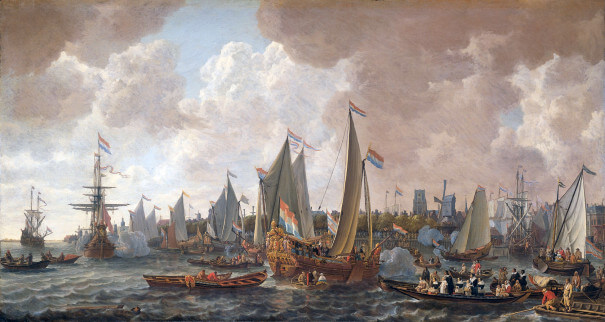
The arrival of King Charles II of England in Rotterdam, May 24 1660
She was a swift lightweight chasing vessel which was used by authorities in the coastal parts of the Low Countries by the Sea to pursue outlaws (1) . During the 17th century has been used by the Dutch as a recreational vessel (2) as well as in informal improvised races both in the Netherlands and in their establishment in North America, which later renamed New York. Such a vessel was used in 1660 for the transfer of the Merry Monarch (Charles II) from Scheveningen of The Hague, United Netherlands in Dover, England following the resolution of the English Parliament to proclaim him king and invite him to return.
Until fairly recently yachts were considered as large and luxurious vessels for the personal use and entertainment of important and wealthy persons. The starting point of this perception is claimed to be that by selecting an important person as Charles II the particular vessel for the carriage of, in connection with such an important purpose as the resumption of his crown, remained in the English perception of that era and therefore into the language, that this foreign watercraft is a vessel for important people. In a public speech, Charles praised the “jaght” which was given to him as a gift at Breda during his exile (3) . Charles and his brother the Duke of York James II, built similar vessels. Particularly two of them competed for prize at the Thames. In deed it was from this royal family that sailing for pleasure was spread between the nobility and the wealthy in England.
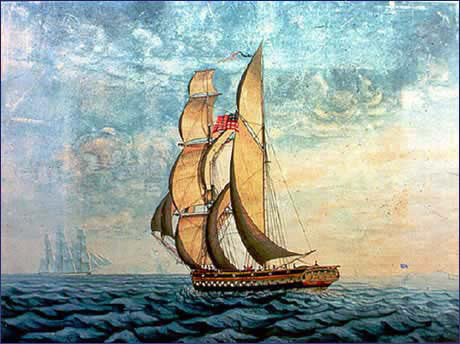
Cleopatra’s Barge
Dutch and English carried on this luxurious pleasure to America. There in Massachusetts, later on in 1816 the recreational vessel Cleopatra’s Barge was built. With this yacht the matter of opulence and luxury ascended to another level. Out of this level the standards for construction of yachts in the coming years were set.
As regards to the shipbuilding type, pleasure vessels did not remain on the lines of the Dutch craft. As early as the starting point of the new lifestyle they followed other known lines of the era as well such as schooners, brigantines and cutters.
From the mid-19th century onwards, transition happens from sail-powered to steam-powered vessels and from the use of wood to the use metal in the construction. Steam engines emerge and afterwards internal combustion engines. The machines start to be used also in the yachts as were in the naval and the merchant ships. At the beginning machines are installed along with sails that remain for a few years as a backup means of propulsion. The new means of propulsion require storage for fuel and reinforced structure. Consequently pleasure vessels are built large to very large and very luxurious also. Therefore these yachts belonged to the private property of very rich people.
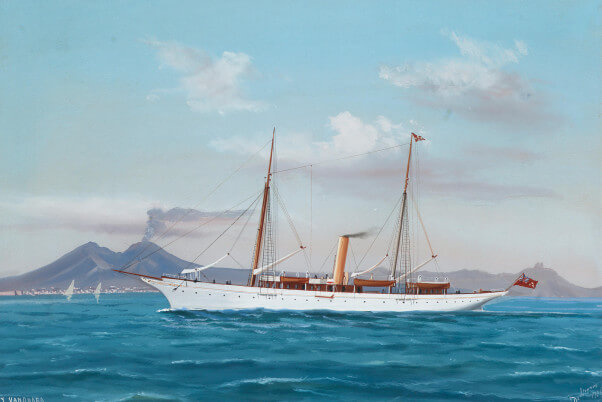
Steam Yacht
In the same period, i.e. from mid-19th century and then, begin to appear in publicity feats with particularly small watercrafts. Their skipper alone and unaided (single handed) sails long distances at the high seas, like the Channel crossing, the Atlantic crossing or even circumnavigating the world. Alongside, books are issued with regards to this kind of adventures at sea. This way it is propagated that small vessels are seaworthy. Small yachts win popularity while many are getting inspired to try yachting. From the time of the Great Depression and after, there has been a reduction in the construction of large and expensive yachts. The trend henceforth is toward the smaller yachts. From there and beyond and in particular from the mid-20th century onwards more and more small size yachts appear. The reason is that as the yacht’s size decreases, the construction cost is reduced at a faster rate than the rate at which the size decreases. Further to this, from the 80s and after they were developed construction methods under which the cost per unit of production was increasingly reduced. The new construction methods use new materials such as fiberglass, and deploy mass production processes based on standard designs. On the other hand there has been a substantial rise in the standards of living, mainly in Western Europe and North America. As a result, there has been more available income for allocation to more affordable in terms of construction cost yachts, either in the form of acquisition or in the form of rental. In this way we saw the considerable flourishing of a new form of holidays and tourism with chartered yachts.
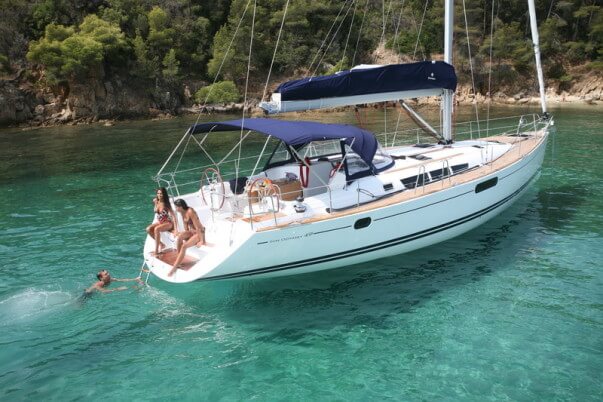
Yachting today is affordable for everyone, especially aboard a yacht rental.
Consequently yacht definition widened from the narrow confines of the large and luxurious pleasure vessel. Now it includes any vessel meant for pleasure which features accommodation. And this is regardless of the primary means of propulsion that can be the sails or the engine of.
So let’s stake out yacht definition: The word emanated from a relatively small and manoeuvrable type of vessel. That vessel was above all very fast because her purpose was to chase other vessels. In the 17th century she was used in competitions where the objective was the speed and the story was the persecution. This and other types were used by important and wealthy persons for pleasure in general. They were built in larger sizes and with great luxury because cost was not an issue for their owners. The more the luxury and the comfort the yachts had the more they were losing their racing character. From the mid-19th century and then small yachts start to appear. These yachts combine the racing character with the recreation prospect providing at least comfortable accommodation if not luxury. By the second half of the 20th century and after the small vessels offering cruising speed and comfort are greatly increased. Nowadays they predominate numerically over the very large and luxurious ones due to the greater acquisition possibilities of by many more people. Well, all these are yachts!
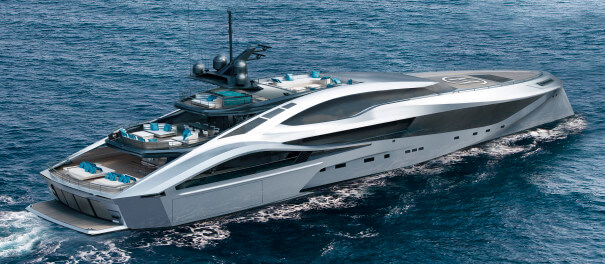
The prevalent element in yacht definition which differentiates her from other vessels, perhaps the unique one, is the kind of use. That is to say, whether used for personal pleasure, something which includes accommodation and at least basic amenities and thence and beyond merely recreational cruise or race. Flagrant example is that following the termination of second World War many individuals bought small warships and turned them into yachts. Therefore a vessel is defined as yacht not just by the design of, but mainly by the way it is used.
Today you don’t need to have high incomes so to enjoy aboard a yacht. No need to buy because you can rent a yacht for a few days and be entertained in any sea of the planet you want. Yachts built for offshore sailing are safe in all sizes. Moreover they provide a wealth of amenities that previously would have been considered a great luxury.
Let’s contemplate that in 1492 Christopher Columbus arrived in the Americas onto his flagship that was just 58 feet or 17.7 meters. We easily realize that the board size that once served the necessities of trade, war, and expansion of hinterland through discoveries, today is a common size for navigable pleasure. Today, we can easily enjoy sailing holidays and we can live regally in the terms of once upon, even for a few days.
So we managed to fit all pleasure crafts (or almost all) within yacht definition. If someone wants to know more about what exactly is included today in yacht definition should look for the types of sailing yachts of catamaran yachts and of motor yachts.
—————————
Yacht definition notes:
- Under the name “jaght” there were also other types of Dutch crafts. One example is the armed three-masted merchant vessel that was used in the 17th century on routes to and from the East Indies. Another example is the “d’Halve Maen” with which Henry Hudson explored in 1609 for the northwest passage of America.
- Pleasure crafts have existed among all seafarer nations from the depths of history. Yet here we look at the origin of the word yacht and what is included into yacht definition.
- The jaght was commissioned by the Dutch East India Company. Charles II named her “Mary” in the honor of his sister.
Further reading:
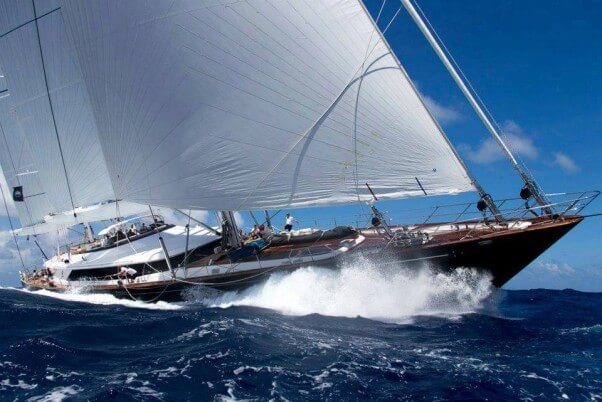
What is a yacht and what isn’t included in this term: What vessels today meet the conditions to be classified as yachts.
Submit a Comment Cancel reply
Your email address will not be published. Required fields are marked *
Save my name, email, and website in this browser for the next time I comment.
Please enter an answer in digits: twenty − 3 =

Pin It on Pinterest
Share this with your friends!
Words and phrases
Personal account.
- Access or purchase personal subscriptions
- Get our newsletter
- Save searches
- Set display preferences
Institutional access
Sign in with library card
Sign in with username / password
Recommend to your librarian
Institutional account management
Sign in as administrator on Oxford Academic
- Hide all quotations
What does the noun yacht mean?
There is one meaning in OED's entry for the noun yacht . See ‘Meaning & use’ for definition, usage, and quotation evidence.
Entry status
OED is undergoing a continuous programme of revision to modernize and improve definitions. This entry has not yet been fully revised.
How common is the noun yacht ?
How is the noun yacht pronounced, british english, u.s. english, where does the noun yacht come from.
Earliest known use
The earliest known use of the noun yacht is in the late 1500s.
OED's earliest evidence for yacht is from before 1584, in the writing of S. Borough.
yacht is a borrowing from Dutch.
Etymons: Dutch jaght(e .
Nearby entries
- yabber, v. 1841–
- yabbering, n. 1839–
- yabble, n. 1827–
- yabble, v. 1808–
- yabbler, n. 1901–
- yabby, n. 1887–
- yabby, v. 1941–
- yabbying, n. 1934–
- yabu, n. 1753–
- yacca, n. 1843–
- yacht, n. a1584–
- yacht, v. 1836–
- yacht basin, n. 1929–
- yacht broker, n. 1882–
- yachtdom, n. 1901–
- yachter, n. 1828–
- yachtery, n. 1861–
- yachtian, n. 1842–
- yachtie, n. 1874–
- yachting, n. 1836–
- yachting, adj. 1847–
Thank you for visiting Oxford English Dictionary
To continue reading, please sign in below or purchase a subscription. After purchasing, please sign in below to access the content.
Meaning & use
Pronunciation, compounds & derived words, entry history for yacht, n..
yacht, n. was first published in 1921; not yet revised.
yacht, n. was last modified in July 2023.
Revision of the OED is a long-term project. Entries in oed.com which have not been revised may include:
- corrections and revisions to definitions, pronunciation, etymology, headwords, variant spellings, quotations, and dates;
- new senses, phrases, and quotations which have been added in subsequent print and online updates.
Revisions and additions of this kind were last incorporated into yacht, n. in July 2023.
Earlier versions of this entry were published in:
OED First Edition (1921)
- Find out more
OED Second Edition (1989)
- View yacht, n. in OED Second Edition
Please submit your feedback for yacht, n.
Please include your email address if you are happy to be contacted about your feedback. OUP will not use this email address for any other purpose.
Citation details
Factsheet for yacht, n., browse entry.
bottom_desktop desktop:[300x250]
- Cambridge Dictionary +Plus
Meaning of yacht in English
Your browser doesn't support HTML5 audio
- They spent their annual holiday on a chartered yacht in the Caribbean .
- He spent three days adrift on his yacht.
- His eyes were fixed on the distant yacht.
- If they can afford a yacht, they must be rolling in it.
- She sailed around the world single-handed in her yacht.
- cabin cruiser
- dragon boat
- rubber dinghy
yacht | American Dictionary
Examples of yacht, collocations with yacht.
These are words often used in combination with yacht .
Click on a collocation to see more examples of it.
Translations of yacht
Get a quick, free translation!

Word of the Day
If you are on hold when using the phone, you are waiting to speak to someone.

Searching out and tracking down: talking about finding or discovering things

Learn more with +Plus
- Recent and Recommended {{#preferredDictionaries}} {{name}} {{/preferredDictionaries}}
- Definitions Clear explanations of natural written and spoken English English Learner’s Dictionary Essential British English Essential American English
- Grammar and thesaurus Usage explanations of natural written and spoken English Grammar Thesaurus
- Pronunciation British and American pronunciations with audio English Pronunciation
- English–Chinese (Simplified) Chinese (Simplified)–English
- English–Chinese (Traditional) Chinese (Traditional)–English
- English–Dutch Dutch–English
- English–French French–English
- English–German German–English
- English–Indonesian Indonesian–English
- English–Italian Italian–English
- English–Japanese Japanese–English
- English–Norwegian Norwegian–English
- English–Polish Polish–English
- English–Portuguese Portuguese–English
- English–Spanish Spanish–English
- English–Swedish Swedish–English
- Dictionary +Plus Word Lists
- English Noun
- American Noun
- Collocations
- Translations
- All translations
To add yacht to a word list please sign up or log in.
Add yacht to one of your lists below, or create a new one.
{{message}}
Something went wrong.
There was a problem sending your report.

What Does Yacht Mean? (The Definition and History Explained)

Ah, the luxurious lifestyle of the yacht.
Whether youve seen one in the harbor or on a distant horizon, the image of a yacht has a certain allure and mystique.
But what exactly is a yacht? From the definition to the different types, the history, and the lifestyle, there is so much to explore.
In this article, we will uncover the mysteries of the yacht, and explore the different types, the races, and the luxury amenities that come with them.
Get ready to set sail!.
Table of Contents
Short Answer
Yacht is a term used to describe a recreational boat or vessel that is used for pleasure trips and sailing.
It typically refers to a larger, more luxurious boat than a regular fishing or leisure boat.
Generally, yachts are meant for longer trips, usually with more than one person on board.
Yachts can range in size depending on the type of boat and its intended use, but all will typically include luxury features and amenities for a comfortable and enjoyable experience.
The Definition of Yacht
Yacht is a term often used to describe a variety of large and luxurious recreational boats, typically used for personal pleasure or sport.
Yachts can be defined as any boat or vessel that is used for leisure and recreational activities.
While the term yacht may be used to describe any kind of boat, it is most commonly used to refer to large, expensive boats designed for recreation, luxury, and leisure.
These vessels are typically larger than other recreational boats, and can range from modest day-sailers to luxury mega-yachts with all the amenities of a home.
Yachts are usually crewed by professional or paid crew and can be used for activities such as fishing, cruising, racing, and even as a floating holiday home.
Yachts may be owned either by individuals or by companies, and typically contain a variety of amenities such as staterooms, sleeping areas, dining areas, and entertainment areas.
Yachts are often used in the charter industry, where they are rented for short-term use, and can be found in harbor cities and coastal towns around the world.
Yachting is a popular recreational activity that has been around for centuries, and can be traced back to ancient Greece.
Yachting has long been associated with wealth and luxury, with the earliest yachts being owned by wealthy aristocrats.
In modern times, yachting has become more accessible to people of all backgrounds, with a variety of yachting activities and vessels available to meet a variety of budgets and preferences.
The term yacht is derived from the Dutch word jacht, which translates to hunt.
The term was originally used to refer to small, fast vessels used by the Dutch navy to chase and capture pirates.
Over time, the term has come to refer to large, luxurious recreational vessels that are often used for pleasure and leisure.
Yachts have become a symbol of wealth and luxury, and are often associated with the lifestyles of the rich and famous.
Types of Yachts

When it comes to yachts, there are several different types available.
The most common type is the sailing yacht, which is propelled through the water by sails and is typically smaller than other types of yachts.
Motor yachts, on the other hand, are powered by an engine and are typically larger than sailing yachts .
Another popular type of yacht is the sport fishing yacht, which combines the luxury of a motor yacht with the convenience of fishing.
These yachts often have advanced navigational equipment, fishing tackle, and other amenities.
Finally, there are luxury yachts, which are the most luxurious of all yachts and typically feature amenities such as jet skis, hot tubs, and full-service bars.
No matter which type of yacht you choose, they all provide a luxurious experience on the water.
Yacht Racing
Yacht racing is one of the most popular activities associated with yachts, and it has a long and storied history.
Yacht racing dates back to the 1800s and has been a popular pastime ever since.
The sport is often divided into two main categories: offshore and inshore racing.
Offshore racing involves navigating the open waters of the ocean, while inshore racing is confined to the waters near shore.
In both types of racing, yachts compete against each other to see who can complete the course in the shortest amount of time.
Yacht racing is typically governed by the rules and regulations of the International Sailing Federation, which sets out a standard for the equipment and safety of the yachts and the sailors onboard.
Yacht racing is a highly competitive sport, and it is a great way to test the skills and strategies of the crew.
There are a variety of different classes of yacht racing, ranging from small dinghies and keelboats to large ocean-going yachts.
The most prestigious class of yacht racing is the America’s Cup, which is the oldest and most prestigious sailing race in the world.
The America’s Cup has been held since 1851 and is now held every four years in a different location.
Yacht racing is an exciting and challenging sport, and it is one of the most popular activities associated with yachts.
Whether it is a day sail or a full-fledged race, yacht racing is a great way to experience the thrill of sailing and the camaraderie of the crew.
Yacht Charters & Cruising

When people think of yachts, they usually think of luxury and leisurely cruising around the ocean.
Yacht charters have become increasingly popular, allowing people to enjoy the freedom of the open seas without having to purchase their own yacht.
Yacht charters offer a variety of packages, depending on the size and amenities of the yacht, the type of cruise being taken, and the number of people being accommodated.
Chartering a yacht is a great way to explore a variety of destinations and enjoy a variety of activities, from fishing and swimming to sightseeing and sunbathing.
Yacht charters typically include a professional crew to manage the vessel, as well as a variety of amenities such as a chef, cabin crew, and a variety of water toys.
Some charter companies even offer special packages for romantic getaways, corporate retreats, or special occasions.
Safety is always a priority when it comes to yacht charters, and all vessels must adhere to strict safety regulations.
All vessels must be inspected and certified by the relevant maritime authority and must be equipped with the necessary safety equipment.
Yacht charters are typically subject to local laws and regulations and must be operated in accordance with all applicable laws and regulations.
Whether youre looking for a private escape or a unique corporate event, yacht charters offer a luxurious and convenient way to explore the open seas.
From discovering new destinations to enjoying the comforts of home away from home, yacht charters provide an unforgettable experience for all.
The History of Yachts
The term yacht has been around since the 1600s, and it has come to represent a broad range of luxurious recreational boats.
The word itself is derived from the Dutch term jacht, which translates to hunt.
In the 1600s, yachts were used for military purposes, such as scouting and patrolling.
Over time, however, the term yacht has come to refer to any large, luxurious recreational boat.
Modern yachts are typically larger than other recreational boats, and range from modest day-sailers to luxury mega-yachts with all the amenities of a home.
Yachts are typically crewed by professional or paid crew and can be used for activities such as fishing, cruising, racing, and even as a floating holiday home.
The evolution of the yacht has been quite remarkable.
In the late 1800s and early 1900s, yachts were primarily used by the wealthy and elite to show off their wealth and status.
Yachts of this era were often quite elaborate and ornate, with richly decorated decks, lavish interior spaces, and even an onboard orchestra.
As technology improved, so did the capabilities of yachts.
In the late 1920s, the modern sailing yacht was invented and became the norm, allowing for a more comfortable and efficient sailing experience.
In the mid-20th century, motor yachts were developed, making navigation and speed much easier.
By the latter part of the 20th century, yacht builders began to focus more on luxury and comfort, with modern yachts featuring amenities such as spas, fitness centers, multiple decks, luxurious cabins, and more.
Today, yachts are still seen as a symbol of wealth and status, and there is a great deal of competition in the luxury yacht market.
There are many different types of yachts to choose from, from modest day-sailers to mega-yachts that can cost millions of dollars.
Yachts of all sizes can be used for a variety of activities, from fishing, cruising, and racing, to simply enjoying the beauty of the open sea.
The Yacht Lifestyle

Yachting is more than just a leisure activity; it is a lifestyle.
From the outside, it might appear to be a glamorous and luxurious pursuit, but there is much more to it than that.
Yachting is a unique way of life that is rich in adventure, exploration, and relaxation.
It is an escape from the hustle and bustle of everyday life, allowing you to explore the world in a more intimate and luxurious way.
Yachting provides an opportunity to experience the world in a way that is both exciting and luxurious.
Whether it be racing around the world or simply enjoying the gentle breeze of a summer day, yachting is a great way to explore the world.
You can explore remote destinations, experience different cultures, and even explore the depths of the sea.
With a yacht, the possibilities are truly endless.
The yacht lifestyle is also a great way to relax and enjoy the finer things in life.
With a yacht, you can enjoy the luxury of a five-star hotel, complete with a dedicated crew to cater to your needs.
On board, you can enjoy fine dining, top-shelf drinks, and all the amenities of a luxurious hotel.
You can also take advantage of the yacht’s amenities, such as a gym, swimming pool, spa, and even a movie theater.
The yacht lifestyle also offers the opportunity to meet new people and build relationships.
With a yacht, you can travel to different ports and meet new people from all over the world.
You can also host events on board, from intimate dinner parties to large gatherings.
At the end of the day, the yacht lifestyle is about living life to the fullest.
It is about exploring the world in luxury and relaxation.
It is about creating memories that will last a lifetime.
Whether you are a racing enthusiast or simply looking for a way to escape from the everyday grind, the yacht lifestyle is an unparalleled experience that is sure to provide a lifetime of memories.
Luxury Amenities of Yachts
When it comes to luxury and comfort, yachts are in a class of their own.
From plush furnishings and spacious cabins to state-of-the-art entertainment systems and private chef-prepared meals, yachts have all the amenities of a home but with the added benefit of being able to take them anywhere in the world.
Whether you’re looking to cruise the Mediterranean, fish the Pacific, or just relax in the Caribbean, yachts are the perfect way to do it in style.
Most yachts come equipped with fully-stocked wet bars, hot tubs, and even private movie theaters, making them the perfect place to entertain family and friends.
There are also plenty of options when it comes to entertainment, from game rooms to fishing equipment, and even water-sports equipment for those looking for a more active vacation.
Yachts also come equipped with the latest navigation and communications systems, so you can stay connected with the world even when you’re out at sea.
With satellite-based communication, you can even stay connected with friends and family back home.
Finally, when it comes to luxury amenities, yachts are the perfect way to pamper yourself.
From private spa treatments to personal chefs and masseuses, yachts provide the perfect opportunity to indulge and relax in style.
Final Thoughts
Yacht is a term that has a long and fascinating history, and today there are a variety of yachts that range from modest day-sailers to luxurious mega-yachts.
Yachts can be used for a variety of activities such as racing and cruising, and also offer a unique lifestyle with various luxury amenities.
If you’re looking to experience the luxury of a yacht, consider chartering one for a special occasion or take a sailing course to learn more about the yacht lifestyle.
No matter what, you’re sure to have a memorable experience.
James Frami
At the age of 15, he and four other friends from his neighborhood constructed their first boat. He has been sailing for almost 30 years and has a wealth of knowledge that he wants to share with others.
Recent Posts
When Was Banana Boat Song Released? (HISTORICAL INSIGHTS)
The "Banana Boat Song" was released in 1956 by Harry Belafonte. This calypso-style song, also known as "Day-O," became a huge hit and remains popular to this day for its catchy tune and upbeat...
How to Make Banana Boat Smoothie King? (DELICIOUS RECIPE REVEALED)
To make a Banana Boat Smoothie King smoothie at home, start by gathering the ingredients: a ripe banana, peanut butter, chocolate protein powder, almond milk, and ice. Blend the banana, a scoop of...

1550s, yeaghe "a light, fast-sailing ship," from Norwegian jaght or early Dutch jaght , both from Middle Low German jacht , shortened form of jachtschip "fast pirate ship," literally "ship for chasing," from jacht "chase," from jagen "to chase, hunt," from Old High German jagon , from Proto-Germanic *yago- , from PIE root *yek- (2) "to hunt" (source also of Hittite ekt- "hunting net"). Related: Yachting ; yachtsman .
Entries linking to yacht
Old English huntian "chase game" (transitive and intransitive), perhaps developed from hunta "hunter," and related to hentan "to seize," from Proto-Germanic *huntojan (source also of Gothic hinþan "to seize, capture," Old High German hunda "booty"), which is of uncertain origin.
Not the usual Germanic word for this, which is represented by Dutch jagen , German jagen (see yacht (n.)). General sense of "search diligently" (for anything) is recorded from c. 1200. Related: Hunted ; hunting . To hunt (something) up "search for until found" is from 1791. Parlor game hunt the slipper is attested from 1766.
also jaeger , "German sharpshooter," 1776, from German Jäger , literally "huntsman," from jagen "to hunt," from Old High German jagon , related to Old Frisian jagia , Dutch jagen "to hunt," Old Norse jaga "to drive, to move to and fro" (see yacht (n.)). Applied to riflemen and sharpshooters in the German and Austrian armies. Englished as yager , yaeger from 1804.
- See all related words ( 5 ) >
Trends of yacht
More to explore, share yacht.
updated on September 28, 2017
Trending words
- 1 . pentecost
- 2 . gallivant
- 4 . marriage
- 5 . galavant
- 6 . hamburger
- 7 . insinuation
Dictionary entries near yacht
yadda-yadda
- English (English)
- 简体中文 (Chinese)
- Deutsch (German)
- Español (Spanish)
- Français (French)
- Italiano (Italian)
- 日本語 (Japanese)
- 한국어 (Korean)
- Português (Portuguese)
- 繁體中文 (Chinese)

Who is Geert Wilders? The pro-Putin 'Dutch Trump' forming the Netherlands' new government
T he Netherlands is getting its ‘most right-wing’ government ever, after four parties finally agreed to govern six months on from the election.
Geert Wilders’ radical right Party for Freedom (PVV) swept to victory in November’s general election , claiming nearly a quarter of the vote.
He more than doubled his party’s vote with a promise to ban mosques and the Quran, limit immigration and stop asylum seekers altogether.
But it’s taken half a year for it to reach a coalition agreement with three other right-of-centre parties – the People’s Party for Freedom and Democracy (VVD), the New Social Contract (NSC), and the Farmer-Citizen Movement (BBB).
Celebrating the news on X today, 60-year-old Wilders wrote: ‘The sun will shine again in the Netherlands.’
Despite convincing other parties to work with him after years of being locked out of power, the blond firebrand with a soft spot for authoritarians won’t be its Prime Minister.
Instead Wilders will continue to show disruptive behaviour and ‘tweet a little bit in the line of Trump’ from outside government, according to Stijn van Kessel, an associate professor of politics at Queen Mary, University of London .
Sign up for Metro's politics newsletter
Not sure what's going on in the world of politics? Ask Alright, Gov? , Metro's brand new politics newsletter.
Sign up here for regular updates from Westminster and beyond, exclusive interviews with big names, and easy-to-read breakdowns of how today's headlines will actually affect you.
Even from the sidelines, Wilders – who has looked up to Russia’s Vladimir Putin and Hungary’s Viktor Orban – may find himself more powerful than ever.
Who is Geert Wilders?
Geert Wilders has always wanted to be prime minister, and he believed it would one day happen.
Something of a giant at nearly 6’5”, he has been an imposing presence in Dutch politics for more than 20 years.
He was first elected to parliament in 1998 as a member of his new coalition partner, the VVD.
But he parted ways in 2004 over his opposition to the possibility of Turkey joining the European Union .
Not one to shrink into the shadows, Wilders launched his own party – the PVV – with a platform focused on opposition to immigration.
Unlike other right-wing parties that have opposed LGBTQ+ rights , Wilders instead framed Muslim immigration in particular as a threat to these liberal Dutch values.
But he himself is no liberal.
Van Kessel told Metro.co.uk : ‘He sees Islam as a violent ideology, he wants to ban mosques and also ban the Quran.
‘These are clearly illiberal policies. He treats a group of citizens as basically non-citizens, who are not entitled to the same rights as the so-called native population.’
He has called Islam ‘an ideology of a retarded culture’, and was convicted of insulting Moroccans.
Wilders also has an affinity for the likes of Hungarian prime minister Viktor Orban, who has seized control of the country’s media and spread antisemitic conspiracy theories .
He praised Wilders election victory, saying: ‘The winds of change are here.’
Wilders has also displayed a fondness for dictator Vladimir Putin, who he has called an ‘ally in the fight against terrorism and mass immigration from Africa’.
What is Geert Wilders’ view on Vladimir Putin, Russia and Ukraine?
Geert Wilders is by no means the most pro-Putin politician in the Netherlands.
His radical right rivals, Thierry Baudet’s Forum for Democracy, have called for the Netherlands to withdraw from NATO , which it blames for Russia’s invasion of Ukraine .
Coincidentally, Baudet has reportedly received funding from, as he describes them, ‘a Russian who works for Putin’, Politico reported.
Although nowhere near Baudet in that sense, Wilders has bucked the trend in terms of Dutch and European leaders’ stances towards Russia.
In 2014, Russian-controlled forces shot down Malaysia Airlines Flight MH17 over Ukraine, killing all 298 people on board, most of them Dutch.
At the time, Wilders’ party demanded that the perpetrators be punished.
But he seemed to forget who those perpetrators were when he visited Moscow just four years later, drawing criticism from the families of Dutch victims.
Having already criticised ‘hysterical Russophobia’ in Europe, Wilders went on to describe Putin as a ‘true patriot’ who is ‘more favourable’ than EU leaders.
Although Wilders has distanced himself from Putin since Russia’s full-scale invasion of Ukraine, he has opposed sanctions on Russia and has shown little desire to support Ukraine .
What does Geert Wilders rise mean for Ukraine?
In a statement today, the PVV reaffirmed it is ‘politically, militarily, financially, and morally against Russian aggression’.
Despite the PVV previously opposing NATO, the new coalition of parties has said ‘it ‘political and military cooperation with NATO is paramount for our international security’.
Van Kessel said: ‘Wilders has moderated his position, he has become less pro-Russia and he explicitly calls Russia the aggressor.’
As Cas Mudde, a Dutch expert on far-right politics, posted on X: ‘Wilders has learned that support for Ukraine has become the new litmus test for “acceptability” within EU.
‘Agree to that and you have more space to weaken liberal democracy at home.’
But on the day Russian forces poured over the borders in a bid to capture all of Ukraine, Wilders posted on X: ‘Do not let Dutch households pay the price for a war that is not ours.’
Since then, he has continued to oppose military aid for Ukraine and has opposed retaliatory sanctions on Russia.
It seems unlikely Wilders will be as keen as the previous prime minister, Mark Rutte, to shop F-16 fighter jets to Ukraine.
And the possibility of a far-right surge in the European Parliament elections next month may cast doubt on continue continent-wide support for Ukraine’s military.
Why is the new Dutch government so right-wing?
The Netherlands is known as a bastion of liberal values.
Cannabis can be bought in coffee shops , it was the first in the world to allow same-sex marriage, and assisted suicide has been legal since 2002.
Its last government was a broad coalition of the conservative-liberal VVD, the liberal D66, along with two Christian democratic parties, ChristenUnie and the CDA.
So it may seem surprising that it now has one of the most right-wing governments in Europe. But this has been a long time coming.
Wind back to October 2019 and you might understand the divisions in society that have led to this point.
It was a dramatic month of protests.
Extinction Rebellion blockaded one of Amsterdam’s main roads for a day.
Farmers caused 1,000km of traffic jams as they flooded cities with tractors, even using one to storm through the doors of a government building as they protested emissions regulations.
Just a month before, the Amsterdam Museum sparked outrage when it dropped the ‘Golden Age’ brand from its 17th century exhibits in recognition of the horrors of imperialism.
Later that year, major cities banned black face on people dressed as Black Pete, the supposedly soot-covered companion of Saint Nicholas , amid accusations of racism .
Meanwhile, opposition to immigration was rising and, with it, support for an array of far-right parties.
Clear divisions were being drawn in the politics of a country where compromise and consensus is the norm.
A new party – the BBB – was formed as the political voice of Dutch farmers.
Populist politicians like Wilders jumped on that bandwagon, forming something of an alliance against the liberal and left-wing politics of D66, Labour and the Greens.
Van Kessel said: ‘The farmer protests are now part of a broader cultural line of conflict, which integrated into the cultural conservative camp.
‘That camp also includes those who are anti-immigration, wary of social change, against multiculturalism, wanting to protect traditional values.
‘This issue of farmers’ interests versus environmental measures has now also been adopted more explicitly by the far-right.
‘And the far-right is traditionally quite against environmental measures imposed from Brussels, and skeptical about climate change.’
The departure of Mark Rutte, the VVD’s bike-riding prime minister who survived numerous controversies in his 14 years of power, cleared a path for Wilders.
Rutte had refused to work with Wilders for most of that time, ever since Wilders pulled the plug on a brief alliance in 2012.
But Rutte’s successor as party leader, Dilan Yeşilgöz, has been far less icy.
During the election campaign, Yeşilgöz, the daughter of Turkish refugees , did not rule out working with Wilders, but she suggested the VVD would only support a centre-right government from the sidelines.
This was perhaps a pivotal moment after years of ‘basically legitimizing the policies of the far-right’ by adopting their stance on immigration.
It signalled to voters that Wilders’ party was a viable contender for government for the first time ever.
Support subsequently rose from just over 10% to 24% on election day. Opinion polls since the election suggest nearly a third of voters would now back the PVV.
It still took some months of negotiations to bridge divides between the four parties and their various interests.
Wilders has had to tone down his opposition to Muslims and park his desire to ban their religious buildings and holy book, in order to appease his coalition partners, not least the more centrist leader of the NSC, Pieter Omtzigt.
Van Kessel said: ‘Even though Omtzigt and the VVD are also keen to limit immigration, this clearly went too far.
‘So what Omtzigt was trying to establish was some guarantees that the rule of law would be protected under this new government.’
Two of the party leaders – Wilders and the BBB’s Caroline van der Plas – certainly looked happier about the agreement than Omtzigt or Yeşilgöz.
But ‘there were few options’, according to van Kessel, who said the only genuine alternative – a coalition including the liberals and the Labour-Green Alliance – would be too unpopular.
‘This is the electoral reality, the voters have given them this outcome.’
Who will actually lead the government as prime minister is yet to be determined.
It may be a former Labour politician who has drifted to the right since his time in government.
But it definitely will not be Wilders, who proves too controversial even for his own coalition partners.
Van Kessel said: ‘He would be a very unlikely figure to have as prime minister given his firebrand character.
‘He continues to tweet a little bit in the line of Trump . His public behaviour is still as radical as it used to be.
‘Maybe it suits him well to remain in parliament and not be under pressure to tone down his rhetoric whilst still seeing his desired policies implemented.’
What will the new Dutch government do?
‘A lot is going to change in the Netherlands’, Wilders declared in a press conference today, announcing what he called ‘the strictest asylum policy ever’.
That’s very much the focus of the new coalition, which led its 26-page programme for government with a paragraph on cracking down on immigration.
Wilders said: ‘There will be an asylum crisis law. We will withdraw the dispersal law. There will be border controls, mobile and otherwise.’
He also promised not to allow asylum seekers – most of whom come from war-torn Syria – to stay in the Netherlands indefinitely.
In line with his support for welfare benefits for the ‘deserving Dutch’, he pledged to prioritise social housing for citizens over refugees and immigrants.
Wilders added: ‘There will be a tougher approach to terror, including towards street terror. And we work towards deporting criminal refugees.’
‘But there is much more to this agreement than asylum policy’, he continued.
He promised to more than half the healthcare insurance deductible, to increase tax relief for ‘the hard-working Dutchman’, to lower energy tax, and invest in healthcare, housing, fishing and farming.
Wilders, who may rule from the sidelines but never the shadows, concluded: ‘The Netherlands will be ours again.’
Get in touch with our news team by emailing us at [email protected] .
For more stories like this, check our news page .
Get your need-to-know latest news, feel-good stories, analysis and more by signing up to Metro's News Updates newsletter

What plans do Dutch nationalist Geert Wilders and his coalition partners have for government?
- Medium Text

IMMIGRATION
Agriculture/environment, taxes/spending cuts, international stance, what's next.
Sign up here.
Reporting by Bart Meijer Editing by Anthony Deutsch and Frances Kerry
Our Standards: The Thomson Reuters Trust Principles. New Tab , opens new tab

World Chevron

Israel pushes further into parts of north Gaza; new cracks in Netanyahu coalition
Fighters attacked Israeli forces in Jabalia and Rafah with anti-tank rockets, mortar bombs, and explosive devices.

Advertisement
Supported by
The Night That Sotheby’s Was Crypto-Punked
The auction that was supposed to be an art world coming-out party for NFTs instead exposed the instability at the heart of the crypto world.
- Share full article

By Zachary Small
This article is adapted from a chapter in the forthcoming book “Token Supremacy: The Art of Finance, the Finance of Art and the Great Crypto Crash of 2022.”
It would have been the greatest insult to rock the Upper East Side on any normal night, but instead the private equity heir Holly Peterson could only laugh. Why had a Sotheby’s official denied her access to a bidding paddle?
In February 2022, Ms. Peterson, an author and art collector, was surrounded by a new clientele: the crypto nouveau riche, who made a temporary home of the art market. Their purchases occurred through the trendy innovation of NFTs, or nonfungible tokens, which registered the ownership of often digital artworks on the blockchain. Collectors then used the NFTs as rapidly appreciating investments to build their crypto fortunes.
The young collectors arrived in sweatpants and greeted one another by their Twitter handles. It was supposed to be another banner evening for the booming art market, where NFTs had come to represent almost half of the industry’s $65 billion valuation in only a couple of years. The marquee lot included 104 CryptoPunks, a selection of algorithmically generated portraits of pixelated people that epitomized the rise of blockchain-based collectibles. They were estimated to sell for $20 million to $30 million, and, for the first time, Sotheby’s had devoted a major sale to just a single lot of NFTs. It was a rare honor — one that hadn’t even occurred when the auction houses had a $450 million Leonardo da Vinci on their hands.
The night received all the marketing gusto that a company serving billionaires and their baubles could muster. Sotheby’s had described the event, called “Punk It!”, as “on par with the most significant and high-profile sales for contemporary and modern art.”
But there were early signs that the NFT market was crashing — a spectacular implosion that would shine a spotlight on the government’s failure to regulate the art market.
Ms. Peterson was one of many traditional collectors who attended the auction to purchase their first NFT. Her father was Peter G. Peterson, the private equity billionaire who founded Blackstone and served as a Museum of Modern Art trustee. And she was a trustee at the Studio Museum in Harlem and on several acquisition committees for organizations like the Whitney Museum of American Art, the Brooklyn Museum and Centre Pompidou.
But none of that pedigree could prepare her for the bizarre scene at Sotheby’s.
Ms. Peterson looked around and saw these new collectors who reminded her of little toddlers with paddles, she recalled in an interview. “What’s going on?” she said. “I’m a Park Avenue woman with a fancy art collection and I couldn’t even get a paddle.”
Buyers could pay in cryptocurrencies or regular dollars. A panel that preceded the sale included Kenny Schachter, a rabble-rousing collector and columnist at Artnet News, who, from his brownstone on the Upper East Side, had situated himself as a communicator between the crypto and traditional art worlds. (He had his own NFT project to promote.) A bulldog for the digital art movement, he managed to corner Max Hollein, the Met Museum director, one evening in Central Park, recalling that the museum executive said that his curators were too scared of the new technology to partake.
Speaking to the V.I.P. attendees at the Sotheby’s auction, Mr. Schachter waxed poetic about the promises of NFTs, saying they had “changed the history of art without even intending to be an art piece in the first place.”
An audience that included celebrity influencers like the rapper Ja Rule and Snoop Dogg’s son Cordell Broadus clapped. Behind the scenes, employees were scrambling to salvage what was supposed to be a historic sale.
According to three people close to the sale, there had been signs of trouble from the beginning of the auction house’s relationship with the seller, who operated from behind the username 0x650d . There was virtually no public information about him; his digital identity was created to promote his CryptoPunk collection, which he purchased in 2021 for around $7 million, saying that he acquired the NFTs “because I choose wealth.”
But he also said that he would never sell them, which should have been Sotheby’s’ first warning sign.
Sotheby’s had been the collector’s second choice to sell his CryptoPunks after he initially failed to secure a deal at Christie’s. And unlike the traditional collectors who attended the auction ready to buy the newfangled art, there was a lack of enthusiasm from crypto collectors. These NFTs were known as “floor punks,” meaning that they lacked certain attributes that gave other CryptoPunks their higher market prices. The algorithm that generated the entire collection of 10,000 images had statistical rarities baked into the code; for example, there were only nine punks dressed as aliens and 24 who looked like apes. (In March 2024, someone reportedly purchased an alien punk for $16 million.) But 0x650d’s collection contained only basic, run-of-the-mill examples of the NFTs originally created by Larva Labs, a studio run by the Canadian software developers Matt Hall and John Watkinson.
So there was little incentive for a serious NFT collector to buy this suite of tokens, especially at a time when purchasing a single CryptoPunk at floor price would have cost about $150,000. A simple calculation would have made clear that at $30 million, Michael Bouhanna, a digital art specialist at Sotheby’s, had overpromised on the total value of the lot by nearly double the high estimate of what a retail trader could find online, where a group of CryptoPunks this size would have gone for around $15 million. And then there was the matter of poor timing. Cryptocurrencies had just taken a nosedive with news that Russia had invaded Ukraine; risky assets looked less enticing with interest rates rising. There was still an appetite for speculation, but perhaps not as much when everyone’s wallets had suddenly depreciated in value. Risk needed some promise of reward.
NFTs Were a Symptom of the Unregulated Art Market
The NFT boom coincided with the art market’s growing reputation as a Wild West where paintings by artists like Marc Chagall and René Magritte turned into vehicles for sanctions evasion, money laundering and fraud, disguised by shell companies.
In 2020, for example, Senate investigators found that auction houses and dealers had allowed two sanctioned Russian oligarchs, the brothers Arkady and Boris Rotenberg, to buy and sell art using shell companies fronted by an art adviser. Their report concluded that brokers went through with the sale despite a failure to determine the true identities of their clients.
Despite that congressional scrutiny, a new era of deregulation was approaching, happening just in time for NFTs to thoroughly scramble the relationship between artistic merit and financial value.
The auction at Sotheby’s took place just weeks after the federal government had shied away from enforcing the Bank Secrecy Act on the art industry, which would have increased the scrutiny of financial transactions and ended the use of shell companies to conceal the true identities of buyers and sellers.
When Congress commissioned a report in 2021 to address concerns that the art market had become a safe haven for a number of financial crimes, the responsibility fell upon the Treasury Department and its aptly named deputy assistant secretary for strategic policy: Scott Rembrandt (no relation to the old Dutch master of the same name), who was unfamiliar with the financial esoterica of the art world.
Dealers were prepared for the worst after regulators in the European Union and Britain banned straw purchases — the practice of buying something on behalf of a secret purchaser — and other schemes that cloaked the true parties behind a painting’s sale.
Anxiety rolled into the next year as the New York attorney general’s office accused Sotheby’s of an alleged tax fraud scheme in which more than a dozen clients obtained false resale certificates to pose as dealers and avoid paying millions in tax revenue on their purchases. A judge allowed the investigation to proceed, saying there was enough evidence that senior members of the auction house “willfully turned a blind eye” to the scheme.
Tight-lipped dealers were not afraid of making noise when their profits were threatened; galleries and auction houses spent nearly $1 million over the past two years on lobbying federal officials in Washington on regulatory issues.
When the Treasury Department released its highly anticipated report in February 2022, it did not recommend immediate government intervention, despite clear evidence of criminal activity.
“We have found that while certain aspects of the high-value art market are vulnerable to money laundering, it’s often the case that there are larger underlying issues at play, like the abuse of shell companies or the participation of complicit professionals” who might look the other way, Mr. Rembrandt said in an interview, implying that art crime was more a byproduct of a flawed financial system than a characteristic of the industry.
But the Treasury official had relied on bad statistics. Mr. Rembrandt said that only $3 billion in money laundering and other financial crimes flowed through the art market every year. That was an errant number, which could be traced back to an unattributed claim from a 1990 article in The Independent by the British journalist Geraldine Norman about the antiquities market. (The Treasury Department did not respond to a request for comment.)
The lack of original research in the Treasury report demonstrated the government’s failure to deeply scrutinize the art market.
NFTs were, in some ways, a result of that oversight. They were more easily abused as vehicles for fraud than other kinds of art by virtue of their digital existence. Sales happened within seconds and without nosy customs officials or know-your-customer practices to impede criminals.
And although Mr. Rembrandt was unwilling to bring federal oversight to the art market, he still specifically called out the rising danger of NFTs in his report, warning: “These types of contracts can create an incentive to shape a marketplace where the work is traded repeatedly in a short period,” and adding that “traditional industry participants, such as art auction houses or galleries, may not have the technical understanding of distributed ledger technology required to practice effective customer identification and verification in this space.”
What happened only a few weeks later at Sotheby’s would illustrate the problems that Mr. Rembrandt raised and highlight the Treasury’s failure to establish new oversight regulations on the art market that would have required the auctioneer to perform more due diligence on its clients.
A Rug Pull to Remember
Back in the salesroom, the audience eagerly looked toward an empty podium where the auctioneer should have started the bidding nearly a half-hour ago. Instead, officials announced that the consignor had withdrawn the lot; everyone was still welcome to enjoy the after-party and listen to the sick beats of D.J. Seedphrase. Stunned, the young crypto investors sipped their last drops of champagne and exited out the auction houses’s revolving doors onto York Avenue. It looked like 0x650d had sized up the money he stood to make at auction and decided that it was unlikely to add up to the number he was looking for.
“The whole evening was totally surreal,” said Ms. Peterson. “The auction definitely made me think that something was rotten.”
For market rainmakers like Amy Cappellazzo, a former Sotheby’s executive, the event was even more significant. “It was an early sign that the crypto market was in trouble.”
NFT collectors needed strong sales to continue their momentum. But catastrophes like the Sotheby’s auction broadcast that the NFT industry’s best days were behind it. Traditional collectors like Ms. Peterson, who might have joined the digital art collectathon, were now backing away while skeptics celebrated proof of the blockchain’s impotence.
“Collectors from the old economy are afraid that their marketplace will be disrupted by these crazy, wacky forces,” Ms. Cappellazzo said. “There is nothing more tried and true than owning a hard asset like a painting and putting it on the wall. But anything that softens a hard asset will make them feel uneasy.”
The anonymous consignor, 0x650d, tried to salvage his online reputation. He posted on Twitter at 7:41 p.m., nearly an hour after pulling the lot, to announce his decision to “hodl,” cryptospeak for holding on to digital assets. About an hour later, he shared a meme that featured the musician Drake, saying he was “taking punks mainstream by rugging Sotheby’s.”
By “rugging,” he meant rug-pulling, a scheme in which crypto developers intentionally attract investors to a project, only to disappear without handing over a product.
Of all the crypto scams that deflated the NFT market, rug pulling was the most notorious and frequent because it transformed good will into a liability; there were at least four such scams that totaled more than $11 million in lost investments involving projects that imitated the Bored Ape Yacht Club , a high-profile set of NFTs. .
But the failed Sotheby’s auction was an unusual moment in which the provocative behavior of the crypto world bled into the art market.
And there was very little strategic benefit to the consignor’s public mocking of the world’s largest auction house; his rug-pull could only be bad for crypto’s reputation.
In the short term, it was clear that 0x650d believed he’d made a smart move. After the auction fiasco, his accounts on social media went silent for nearly a month, until April 2022, when he announced that his CryptoPunks collection would be used as collateral for an $8.32 million loan, unlocking the liquidity of his NFTs while allowing him to “retain upside exposure” through the collectibles. That loan appeared to be 40 percent of the low estimate that Sotheby’s had given for the value of his collection, indicating that 0x650d was able to use the auction house’s appraisal to legitimize the value of his NFTs. It let him keep his punks, so that he could, theoretically, sell them for more than he would have made at Sotheby’s — and use them as a piggy bank for liquidity in the meantime. It looked as if he’d used the art world as a mark.
But two years later, thanks in large part to the art world’s distrust of NFTs, Crypto Punks are worth far less. 0x650d appears to still hold his lot, which is now worth about $12.3 million, a significant decrease from the $20 million that he turned his nose up at Sotheby’s.
Zachary Small is a Times reporter writing about the art world’s relationship to money, politics and technology. More about Zachary Small
Inside the World of Cryptocurrencies
Customers of the failed cryptocurrency exchange FTX are poised to recover all of the money they lost when the firm collapsed in 2022 and receive interest on top of it, the company’s bankruptcy lawyers said.
Changpeng Zhao , the billionaire founder of the giant cryptocurrency exchange Binance, was sentenced to four months in prison , a much lighter penalty than other crypto executives have faced since the industry imploded in 2022.
Two years after the cryptocurrency market crashed, there are signs that crypto is booming again in the Philippines , long a center of crypto activity.
Pushed by a nonprofit with ties to the Trump administration, Arkansas became the first state to shield noisy cryptocurrency operators from unhappy neighbors. A furious backlash has some lawmakers considering a statewide ban .
Ben Armstrong, better known as BitBoy, was once the most popular cryptocurrency YouTuber in the world. Then his empire collapsed .

IMAGES
VIDEO
COMMENTS
A yacht ( / jɒt /) is a sailing or power vessel used for pleasure, cruising, or racing. [2] [3] [4] There is no standard definition, though the term generally applies to vessels with a cabin intended for overnight use. To be termed a yacht, as opposed to a boat, such a pleasure vessel is likely to be at least 33 feet (10 m) in length and may ...
YACHT - translate into Dutch with the English-Dutch Dictionary - Cambridge Dictionary
This word comes from the Dutch word "jacht", which means "hunt". Furthermore, " jachtschepen" was the name for narrow, light and very fast sailing boats that the Dutchmen were using for intercepting larger and slower boats and ships. One of the 'hunters' was given as a present to the British king Charles II.
Yacht : modern meaning of the term and types of boats. The etymology of the term yacht comes from the Dutch word 'jacht', which was used in the past to define the fast sailing vessels used to hunt down pirates along the coasts of northern Europe. Today, the term 'yacht' is used to describe all recreational vessels, whether sailing or ...
A yacht Etymology [edit]. Circa 1557; variant of yaught, earlier yeaghe (" light, fast-sailing ship "), from Dutch jacht (" yacht; hunt "), in older spelling jaght(e), short for jaghtschip (" light sailing vessel, fast pirate ship ", literally " pursuit ship "), compound of jacht and schip (" ship ").. In the 16th century the Dutch built light, fast ships to chase the ships ...
A yacht is more than a vessel; it's a symbol of luxury and sophistication. Derived from the Dutch word "jacht," meaning "hunt" or "chase," yachts were initially swift, maneuverable ships used for pursuit. Over time, yachts have evolved into opulent pleasure craft enjoyed by sailing enthusiasts and the elite.
Yacht Definition & Origin. The word yacht comes from the Dutch word "jacht", which means to hunt, and refers to the quick and lightweight sailboats the Dutch navy used to pursue pirates and other enemies in shallow waters. Today, the word takes on a very different meaning. While there is no strict definition of the word today, a yacht is ...
Yacht definitions: A brief history. Whilst boating for fun dates back to Ancient Egypt and possibly even further than that, the word yacht comes from the Dutch 'jachtschip', which means hunting ship. Jachts were originally a class of sailboat used in the 16th century to hunt down enemies of the Dutch Republic.
It has been specially developed for bonding and sealing applications in the yacht-and boat building industry.: Het is speciaal ontwikkeld voor verlijmingen in de jacht-en scheepsbouw.: Therefore, The Krimpen aan den IJssel location is also suitable for carrying out large yacht-and shipbuilding projects as well as building large steel constructions.: Dit maakt de locaties in Krimpen aan den ...
Yacht. A yacht (pronounced "yot") is a type of boat which is mainly used for recreation. [1] It usually has a cabin, so it does not need to return to the harbour overnight. Originally, yachts were sailing-boats, but now there are also motor yachts. The name comes from the Dutch word jachtschip, which originally meant hunting-boat or fast boat.
As the Dutch rose to preeminence in sea power during the 17th century, the early yacht became a pleasure craft used first by royalty and later by the burghers on the canals and the protected and unprotected waters of the Low Countries.Racing was incidental, arising as private matches.English yachting began with King Charles II of England during his exile in the Low Countries.
yacht: [noun] any of various recreational watercraft: such as. a sailboat used for racing. a large usually motor-driven craft used for pleasure cruising.
The term "yacht" derives from the Dutch word jacht, meaning "hunt". When yachting with sailboats, the activity is simply called sailing; and with motorboats, it is called powerboating. A boat club that only services yachting participants is known as a yacht club.
The term YACHT is originated from the obsolete Dutch word "jaght", which comes from the Middle Saxon "jacht" meaning hunt or to pursue, which is also the short for jachtschip which means hunting ship / ship for chasing. "Jacht" has Proto-Germanic root just like German "Jäger" which means hunter.
In Dutch jaght (pronounced /ˈjɒt/) means hunting or hunt. This Dutch word is the precursor to the modern term yacht. Although best known for their more recent (and fun!) exploits in cannabis tourism, the Dutch Navy were shockingly more famous and well-known for their sailing expertise.
There is one meaning in OED's entry for the noun yacht. See 'Meaning & use' for definition, usage, and quotation evidence. Entry status. OED is undergoing a continuous programme of revision to modernize and improve definitions. ... yacht is a borrowing from Dutch. Etymons: Dutch jaght(e.
A sailing yacht (US ship prefixes SY or S/Y), is a leisure craft that uses sails as its primary means of propulsion. A yacht may be a sail or power vessel used for pleasure, cruising, or racing. [1] [2] [3] There is no standard definition, so the term applies here to sailing vessels that have a cabin with amenities that accommodate overnight ...
How to say yacht in Dutch What's the Dutch word for yacht? Here's a list of translations. Dutch Translation. jacht. More Dutch words for yacht. jacht noun: hunting, hunt, chase, pursuit, shooting: jachten verb: hurry, hustle, flutter: Find more words!
YACHT definition: 1. a boat with sails and sometimes an engine, used for either racing or travelling on for pleasure…. Learn more.
Yacht is a term used to describe a recreational boat or vessel that is used for pleasure trips and sailing. It typically refers to a larger, more luxurious boat than a regular fishing or leisure boat. Generally, yachts are meant for longer trips, usually with more than one person on board.
The word "yacht" is derived from the Dutch word for "hunter." The first yachts were exactly that: pirate hunters. ... Thus, by definition, yachts are considered capable of extended cruises over more demanding water conditions in the open sea. To facilitate this, yachts tend to have a greater, more advanced cadre of instruments and ...
yacht. (n.) 1550s, yeaghe "a light, fast-sailing ship," from Norwegian jaght or early Dutch jaght, both from Middle Low German jacht, shortened form of jachtschip "fast pirate ship," literally "ship for chasing," from jacht "chase," from jagen "to chase, hunt," from Old High German jagon, from Proto-Germanic *yago-, from PIE root *yek- (2) "to ...
Yacht definition: a vessel used for private cruising, racing, or other noncommercial purposes.. See examples of YACHT used in a sentence.
The Netherlands is getting its 'most right-wing' government ever, after four parties finally agreed to govern six months on from the election. Geert Wilders' radical right Party for Freedom ...
Throughout college, I owned a pair of boat shoes that were, in a word, vile. I wore them until the soles were as thin as a Pringle and they stank like an elephant. By sophomore year, they were ...
After months of tense negotiations, Dutch nationalist Geert Wilders and his coalition partners have struck a deal to form a right-wing government. Here is an overview of their main plans:
The auction that was supposed to be an art world coming-out party for NFTs instead exposed the instability at the heart of the crypto world. By Zachary Small This article is adapted from a chapter ...